Paul van Yperen's Blog, page 150
August 27, 2021
Ivo's Bologna finds
Another fun post. This time EFSP shows a selection of the postcards that Ivo Blom found at the Il Cinema Ritrovato Book Fair in Bologna, or the 'Mostra mercato dell'editoria cinematografica'. This fair is held every year during the Bologna film festival in the setting of the Biblioteca Renzo Renzi at the Piazzetta Pier Paolo Pasolini.
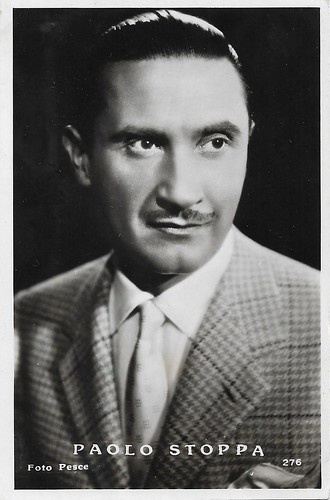
Italian postcard by A. Terzoli, Roma / Stabilimenti Angeli, Terni, no. 276. Photo: Pesce.
Italian character actor Paolo Stoppa (1906–1988) is best known for his stage work with director Luchino Visconti. In a career of more than 50 years, he also appeared in such cinema classics as Miracolo a Milano (1951), Il Gattopardo (1962), and Once Upon a Time in the West (1968).
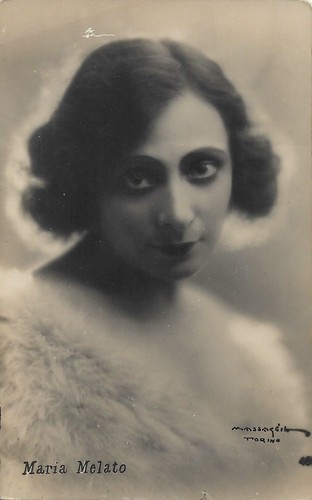
Italian postcard by Ballerini & Fratini, no. 31. Photo: Massaglia, Torino.
Italian actress Maria Melato (1885-1950) appeared in the theatre, on the radio, and in the cinema. Her films included Ritorno/Return (1914), Anna Karenina (1917), and Il volo degli aironi/The flight of the herons (1920). Unfortunately, all of her films are considered lost.
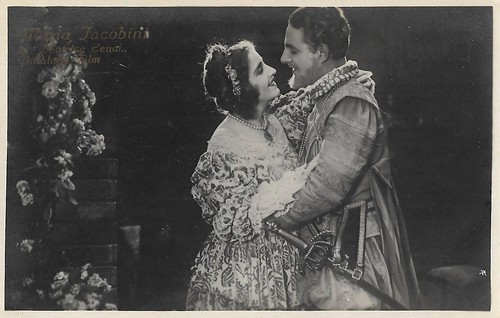
Italian postcard by G.B. Falci, Milano, no. 663. Photo: Pittaluga Films. Maria Jacobini as the title character and probably Gino Talamo as her lover Olimpio Calvetti in Beatrice Cenci (Baldassarre Negroni, 1926). Jacobini stars in this film based on the true events of the murder of the cruel, violent, frugal and rapist Count Francesco Cenci, by his daughter Beatrice, her lover Calvetti, the carpenter nicknamed The Catalan, Beatrice's stepmother Lucrezia, and Beatrice's brothers Giacomo and Bernardo. Pope Clemens VIII shows no clemency despite his name, and all but the youngest brother Bernardo are killed.
Among the Italian divas, Maria Jacobini (1892-1944) was an island of serenity, as film historian Vittorio Martinelli expressed it. She was the personification of goodness, of simple love. Her weapon was her sweet and gracious smile. However, in some Italian, and later also in German films, she could as well play the vivacious lady, the femme fatale, the comedienne, the hysterical victim, or the suffering mother or wife.
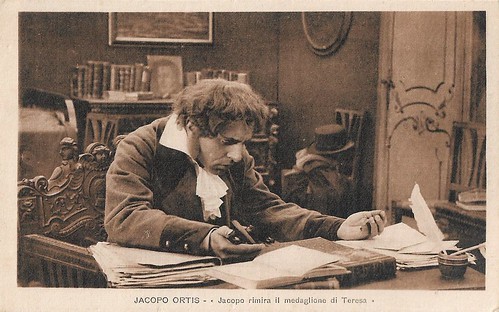
Italian postcard by IPA CT Duplex, V. Uff. Rev. St. Terni, no. 9500. Photo: Milano Films. Luigi Duse as the title character in Jacopo Ortis (Giuseppe Sterni, 1918). Caption: Jacopo admires the medallion of Teresa.
Italian stage and film actor Luigi Duse (1857-1930) was parented to the Duse stage actors family to which also famous stage actress Eleonora Duse belonged.
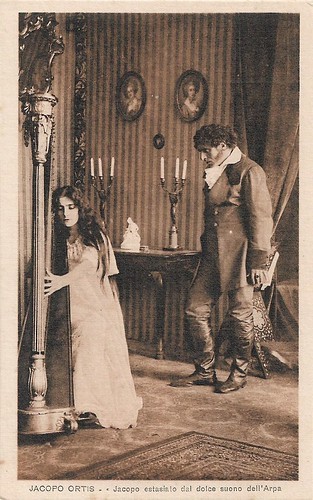
Italian postcard by IPA CT Duplex, V. Uff. Rev. St. Terni, no. 9504. Photo: Milano Films. Paola Borboni as Teresa and Luigi Duse as the title character in Jacopo Ortis (Giuseppe Sterni, 1918), Caption: Jacopo in ecstasies over the sweet sound of the harp.
Paola Borboni (1900-1995) was one of the greatest stage actresses of Italy who also played in many films. She was often heard on the radio and seen on television, but her true passion was the stage.
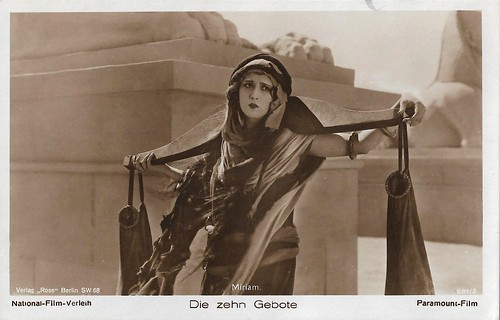
German postcard by Ross Verlag, no. 681/2. Photo: Paramount-Film / National-Verleih. Estelle Taylor as Miriam, sister of Moses in The Ten Commandments (Cecil B. DeMille, 1923). Caption: Miriam.
Estelle Taylor (1894–1958) was an American actress, singer, model, and animal rights activist. With "dark-brown, almost black hair, and brown eyes", she was regarded as one of the most beautiful silent film stars of the 1920s.
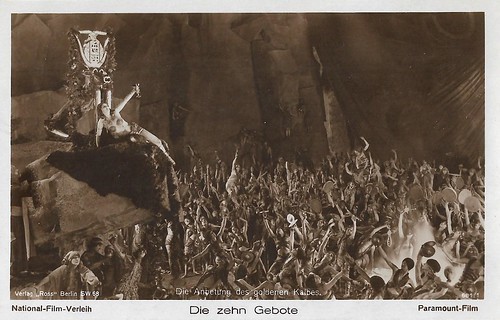
German postcard by Ross Verlag, no. 681/1. Photo: Paramount-Film / National-Verleih. Estelle Taylor as the woman who embraces the Golden Calf, in The Ten Commandments (Cecil B. DeMille, 1923). Caption: The Adoration of the Golden Calf.
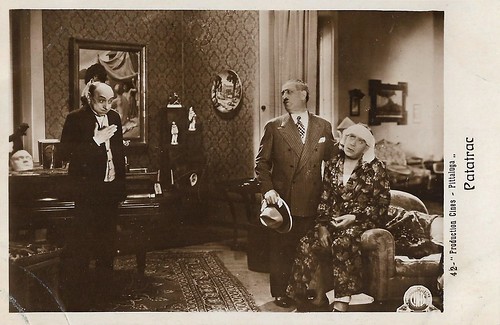
Italian postcard in the Cines-Pittaluga series by Ed. G.B. Falci, Milano, no. 42. Photo: Cines-Pittaluga. Armando Falconi (the man with the bandage) as count Armando, and possibly left Giuseppe Pierozzi as the little creditor and Arturo Falconi as Armando's best friend Paolino in Patatrac (Gennaro Righelli, 1931).
Armando Falconi (1871-1954) was an Italian stage and screen actor. Though he was foremost a theatre actor and comedian, he had a prolific career as a comedian in Italian cinema of the 1930s and early 1940s.
Arturo Falconi (1867-1934) acted in some 11 Italian silent films between 1916 and 1918, most of which were directed by Guido Brignone and starring Lola Visconti-Brignone and Falconi himself. He returned to the sets in 1931 for 8 more films between 1931 and 1935, starting with Patatrac (1931).
Little Giuseppe Pierozzi (1883-1956) was a typical character actor in Italian who acted in some 125 Italian silent and sound films between 1917 and 1954.
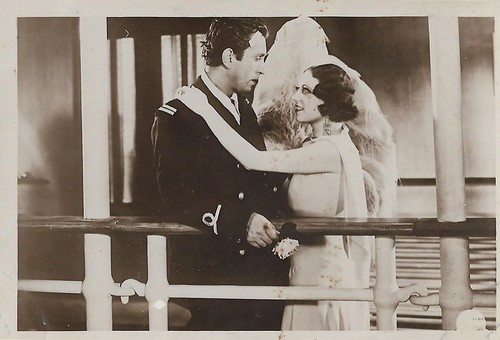
Italian postcard by Ed. G.B. Falci, Milano. Photo: Cines-Pittaluga. Carlo Fontana and probably Enrica Fantis in the Italian early sound film Vele ammainate/Lowered Sails (Anton Giulio Bragaglia, 1931). The front and back of the card don't indicate the film title but we managed to identify it. See also our blog post on the film at European Film Star Postcards.
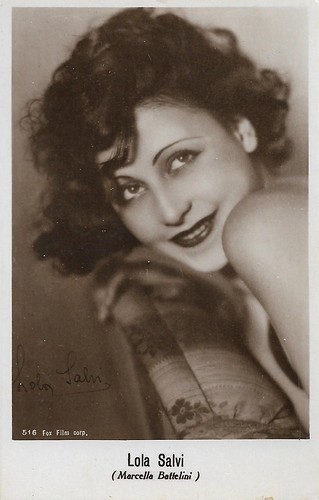
Italian postcard by Ed. G.B. Falci, Milano, no. 516. Photo: Fox Film Corp. Lola Salvi as Marcelle in Plastered in Paris (Benjamin Stoloff, 1928). The film was shot as a silent production, but afterward, a soundtrack with music was added.
Lola Salvi was an Italian actress, whose real name was Marcella Battelini. Born in Trieste, Battelini won a beauty contest by Fox in Italy. Her mother accompanied her to Hollywood, where she had a female lead in Plastered in Paris (1928), a comedy about two American veterans who visit Paris and end up in the French Foreign Legion. The film clearly mocked Foreign Legion dramas such as Beau Geste, while the two male leads were caricatures of the Jew with the big nose and the dumb Swede. Salvi then was cast as an Italian girl in her first sound film, Irving Cummings, and Raoul Walsh's In Old Arizona, Fox's first all-sound film, but her role was small and uncredited. After another small role, as a maid in Thru Different Eyes (John G. Blystone, 1929), Fox ended her contract.
The site Bizarre Los Angeles notes that afterward, she agreed to costar in a film by another Fox outcast actor, the former Brazilian journalist Olympio Guilherme, who also had been hired by Fox after winning a contest: "Guilherme decided to make his own film. Using hidden cameras on the streets of Los Angeles, he and Salvi interacted with each other as well as other Angelenos, who didn’t know they were being filmed. As a result, he completed Hunger, a drama that depicted the hardships of Latino Americans trying to survive in Los Angeles in the late 1920s." The Spanish title of the film is Fome (1929).
Sources: Bizarre Los Angeles and .

Italian postcard by A. Terzoli, Roma / Stabilimenti Angeli, Terni, no. 276. Photo: Pesce.
Italian character actor Paolo Stoppa (1906–1988) is best known for his stage work with director Luchino Visconti. In a career of more than 50 years, he also appeared in such cinema classics as Miracolo a Milano (1951), Il Gattopardo (1962), and Once Upon a Time in the West (1968).

Italian postcard by Ballerini & Fratini, no. 31. Photo: Massaglia, Torino.
Italian actress Maria Melato (1885-1950) appeared in the theatre, on the radio, and in the cinema. Her films included Ritorno/Return (1914), Anna Karenina (1917), and Il volo degli aironi/The flight of the herons (1920). Unfortunately, all of her films are considered lost.

Italian postcard by G.B. Falci, Milano, no. 663. Photo: Pittaluga Films. Maria Jacobini as the title character and probably Gino Talamo as her lover Olimpio Calvetti in Beatrice Cenci (Baldassarre Negroni, 1926). Jacobini stars in this film based on the true events of the murder of the cruel, violent, frugal and rapist Count Francesco Cenci, by his daughter Beatrice, her lover Calvetti, the carpenter nicknamed The Catalan, Beatrice's stepmother Lucrezia, and Beatrice's brothers Giacomo and Bernardo. Pope Clemens VIII shows no clemency despite his name, and all but the youngest brother Bernardo are killed.
Among the Italian divas, Maria Jacobini (1892-1944) was an island of serenity, as film historian Vittorio Martinelli expressed it. She was the personification of goodness, of simple love. Her weapon was her sweet and gracious smile. However, in some Italian, and later also in German films, she could as well play the vivacious lady, the femme fatale, the comedienne, the hysterical victim, or the suffering mother or wife.

Italian postcard by IPA CT Duplex, V. Uff. Rev. St. Terni, no. 9500. Photo: Milano Films. Luigi Duse as the title character in Jacopo Ortis (Giuseppe Sterni, 1918). Caption: Jacopo admires the medallion of Teresa.
Italian stage and film actor Luigi Duse (1857-1930) was parented to the Duse stage actors family to which also famous stage actress Eleonora Duse belonged.

Italian postcard by IPA CT Duplex, V. Uff. Rev. St. Terni, no. 9504. Photo: Milano Films. Paola Borboni as Teresa and Luigi Duse as the title character in Jacopo Ortis (Giuseppe Sterni, 1918), Caption: Jacopo in ecstasies over the sweet sound of the harp.
Paola Borboni (1900-1995) was one of the greatest stage actresses of Italy who also played in many films. She was often heard on the radio and seen on television, but her true passion was the stage.

German postcard by Ross Verlag, no. 681/2. Photo: Paramount-Film / National-Verleih. Estelle Taylor as Miriam, sister of Moses in The Ten Commandments (Cecil B. DeMille, 1923). Caption: Miriam.
Estelle Taylor (1894–1958) was an American actress, singer, model, and animal rights activist. With "dark-brown, almost black hair, and brown eyes", she was regarded as one of the most beautiful silent film stars of the 1920s.

German postcard by Ross Verlag, no. 681/1. Photo: Paramount-Film / National-Verleih. Estelle Taylor as the woman who embraces the Golden Calf, in The Ten Commandments (Cecil B. DeMille, 1923). Caption: The Adoration of the Golden Calf.

Italian postcard in the Cines-Pittaluga series by Ed. G.B. Falci, Milano, no. 42. Photo: Cines-Pittaluga. Armando Falconi (the man with the bandage) as count Armando, and possibly left Giuseppe Pierozzi as the little creditor and Arturo Falconi as Armando's best friend Paolino in Patatrac (Gennaro Righelli, 1931).
Armando Falconi (1871-1954) was an Italian stage and screen actor. Though he was foremost a theatre actor and comedian, he had a prolific career as a comedian in Italian cinema of the 1930s and early 1940s.
Arturo Falconi (1867-1934) acted in some 11 Italian silent films between 1916 and 1918, most of which were directed by Guido Brignone and starring Lola Visconti-Brignone and Falconi himself. He returned to the sets in 1931 for 8 more films between 1931 and 1935, starting with Patatrac (1931).
Little Giuseppe Pierozzi (1883-1956) was a typical character actor in Italian who acted in some 125 Italian silent and sound films between 1917 and 1954.

Italian postcard by Ed. G.B. Falci, Milano. Photo: Cines-Pittaluga. Carlo Fontana and probably Enrica Fantis in the Italian early sound film Vele ammainate/Lowered Sails (Anton Giulio Bragaglia, 1931). The front and back of the card don't indicate the film title but we managed to identify it. See also our blog post on the film at European Film Star Postcards.

Italian postcard by Ed. G.B. Falci, Milano, no. 516. Photo: Fox Film Corp. Lola Salvi as Marcelle in Plastered in Paris (Benjamin Stoloff, 1928). The film was shot as a silent production, but afterward, a soundtrack with music was added.
Lola Salvi was an Italian actress, whose real name was Marcella Battelini. Born in Trieste, Battelini won a beauty contest by Fox in Italy. Her mother accompanied her to Hollywood, where she had a female lead in Plastered in Paris (1928), a comedy about two American veterans who visit Paris and end up in the French Foreign Legion. The film clearly mocked Foreign Legion dramas such as Beau Geste, while the two male leads were caricatures of the Jew with the big nose and the dumb Swede. Salvi then was cast as an Italian girl in her first sound film, Irving Cummings, and Raoul Walsh's In Old Arizona, Fox's first all-sound film, but her role was small and uncredited. After another small role, as a maid in Thru Different Eyes (John G. Blystone, 1929), Fox ended her contract.
The site Bizarre Los Angeles notes that afterward, she agreed to costar in a film by another Fox outcast actor, the former Brazilian journalist Olympio Guilherme, who also had been hired by Fox after winning a contest: "Guilherme decided to make his own film. Using hidden cameras on the streets of Los Angeles, he and Salvi interacted with each other as well as other Angelenos, who didn’t know they were being filmed. As a result, he completed Hunger, a drama that depicted the hardships of Latino Americans trying to survive in Los Angeles in the late 1920s." The Spanish title of the film is Fome (1929).
Sources: Bizarre Los Angeles and .
Published on August 27, 2021 22:00
August 26, 2021
Keira Knightley
British actress Keira Knightley (1985) has starred in both independent films and big-budget blockbusters and she is particularly noted for her roles in period dramas. In 2006, she was nominated for both an Academy Award and a Golden Globe for her lead role as Elizabeth Bennet in the book adaptation Pride & Prejudice (2005).
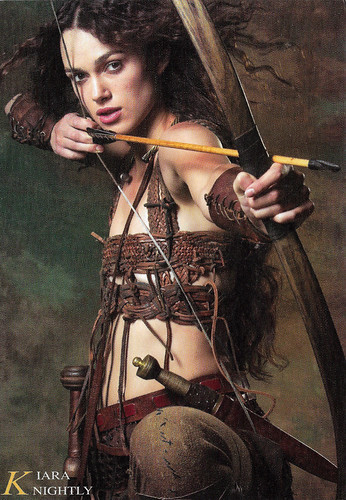
Vintage postcard. Keira Knightley in King Arthur (Antoine Fuqua, 2004). Knightley's first name is misspelled here as Kiara.
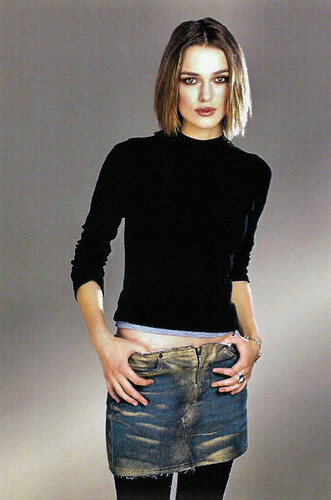
Chinese postcard by Oriental City Publishing Group Limited.
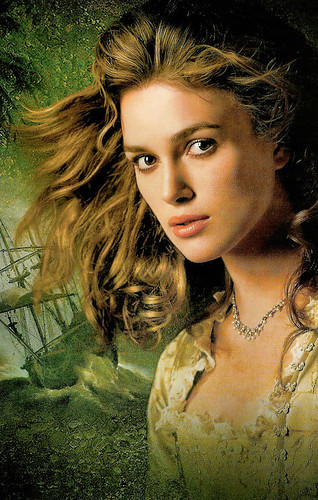
Vintage postcard by Idoles. Photo: Walt Disney Pictures. Keira Knightley in Pirates of the Caribbean - Dead Man's Chest (Gore Verbinski, 2006).
A tomboy football player struggling against social norms
Keira Christina Righton-Knightley OBE was born in 1985 in London to stage actor Will Knightley and acclaimed playwright Sharman Macdonald. Knightley has an older brother, Caleb. Keira attended Teddington School.
At age six, she obtained an agent and initially acted in commercials and television films. She focused on art, history, and English literature while studying at Esher College, but left after a year to pursue an acting career.
On TV, Keira played Natasha Jordan, a young girl whose mother (Sophie Ward) is involved in an extramarital affair, in the romantic drama A Village Affair (Moira Armstrong, 1995). She showed unusually artistic tastes in her early roles, playing the young Gabrielle Anwar in Innocent Lies (Patrick DeWolf, 1995) and the youthful Emily Mortimer in the Rosamund Pilcher TV adaptation Coming Home (Giles Foster, 1998).
In the cinema, she appeared as Sabé, Queen Padmé Amidala's (Natalie Portman) handmaiden and decoy, in the Science-Fiction blockbuster Star Wars: Episode I – The Phantom Menace (George Lucas, 1999). Her resemblance to Portman at the time was such that her appearance during the promotion of the film was kept a secret. Outwardly, it was maintained that Portman played both Amidala and Sabé.
Her first major role, she had in the Walt Disney Productions TV film Princess of Thieves (Peter Hewitt, 2001). Knightley played the daughter of Robin Hood. Concurrently, she appeared in The Hole (Nick Hamm, 2001), a thriller that received a direct-to-video release in the US.
Despite having appeared in over a dozen film and television roles, Knightley struggled to get a breakthrough until portraying a tomboy soccer player in the British sports film Bend It Like Beckham (Gurinder Chadha, 2001), co-starring Parminder Nagra and Jonathan Rhys Meyers. Knightley portrayed Jules, a tomboy football player struggling against social norms who convinces her friend to pursue the sport. The film was a surprise critical and commercial success with a gross of $76.6 million at the box office.
As Lara Antipova in the TV miniseries Doctor Zhivago (Giacomo Campiotti, 2002), Knightley gracefully slipped into a role that was previously made famous by Julie Christie , and the timeless romantic drama proved a hit with British television viewers.
Knightley achieved global stardom at age 18 when she portrayed the role of Elizabeth Swann opposite Orlando Bloom and Johnny Depp in the fantastic Swashbuckler Pirates of the Caribbean: The Curse of the Black Pearl (Gore Verbinski, 2003).
"Her debut Hollywood film, writes Alexander Larman at Screenonline, "allowed her to look fetching while battling undead pirates, but she remained subsidiary to Johnny Depp 's grandstanding hamming - though not enough to prevent her being cast in the two sequels." The film opened at number one on the box office, and became one of the highest-grossing releases of the year, with worldwide revenues of $654 million.
In the same year, she played a cameo in the Christmas romantic comedy Love Actually (Richard Curtis, 2003) alongside some of the best-known British film actors of the time including Alan Rickman, Hugh Grant , Emma Thompson, Liam Neeson, Rowan Atkinson, and Colin Firth. It became another box-office success, grossing $246 million worldwide on a budget of $40–45 million. Frequently shown during the Christmas season, the film has proved more popular with audiences than critics, and it has been discussed as being arguably a modern-day Christmas staple.
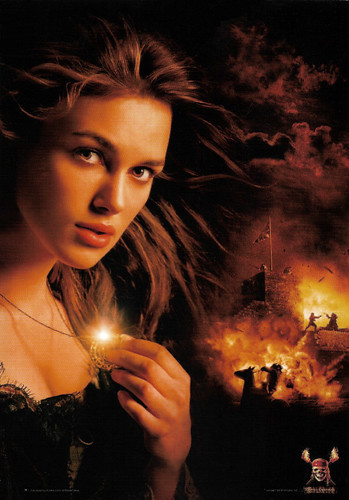
French postcard by Sonis, no. C. 1705. Photo: Disney. Keira Knightley in Pirates of the Caribbean - Dead Man's Chest (Gore Verbinski, 2006).
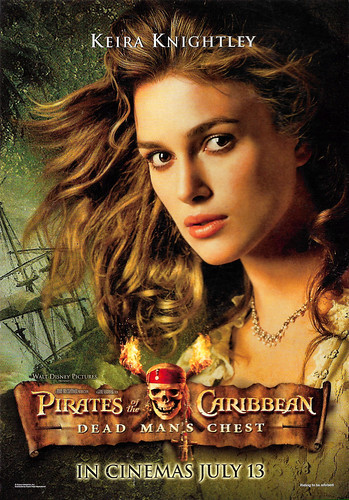
British postcard by Arcards, no. 0842. Photo: Walt Disney Pictures. Keira Knightley in Pirates of the Caribbean - Dead Man's Chest (Gore Verbinski, 2006).
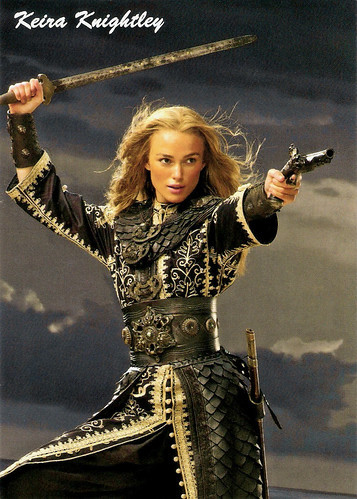
Vintage postcard. Keira Knightley in Pirates of the Caribbean: At World's End (Gore Verbinski, 2007).
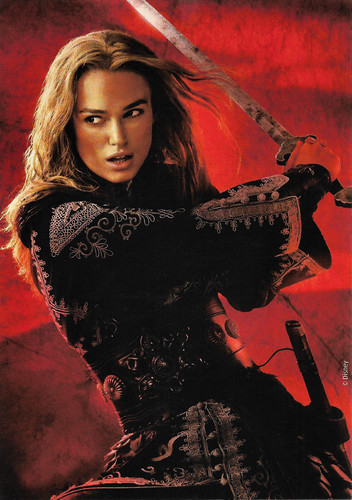
Belgian postcard by Nieuwsblad.be. Keira Knightley in Pirates of the Caribbean: At World's End (Gore Verbinski, 2007).
Elizabeth Bennet and Elizabeth Swann
Keira Knightley gave a feisty performance as Guinevere in King Arthur (Antoine Fuqua, 2004) opposite Clive Owen and Ioan Gruffudd. It reinforced her credentials as a contemporary action heroine. Then she portrayed Elizabeth Bennet in an adaption of Jane Austen's Pride & Prejudice (Joe Wright, 2005), which earned Knightley her first Golden Globe and Oscar nominations. At age 20, she became the second-youngest Best Actress nominee.
In 2006, she reprised her role as Elizabeth Swann in the second and third productions of the Pirates of the Caribbean series, Pirates of the Caribbean: Dead Man's Chest (Gore Verbinski, 2006) and Pirates of the Caribbean: At World's End (Gore Verbinski, 2007).
Knightley then starred in a series of further period pieces, portraying a complex love interest in Atonement (Joe Wright, 2007) with James McAvoy, tastemaker Georgiana Cavendish in The Duchess (Saul Dibb, 2008), and the titular socialite in Anna Karenina (Joe Wright, 2012).
She then forayed into contemporary dramas, appearing as an aspiring musician in Begin Again (John Carney, 2013) and a medical student in the spy thriller Jack Ryan: Shadow Recruit (Kenneth Branagh, 2014), starring Chris Pine. Knightley returned to historical films by playing Joan Clarke, a woman who helped crack German codes during WWII, in The Imitation Game (Morten Tyldum, 2014), earning her a second round of Academy Award and BAFTA nominations, and by starring as the eponymous belle époque writer in Colette (Wash Westmoreland, 2018) to critical acclaim.
Knightley reprised the role of Elizabeth Swann with a cameo appearance in Pirates of the Caribbean: Dead Men Tell No Tales (Joachim Rønning, Espen Sandberg, 2017) after test audiences repeatedly inquired about her character. On stage, she has appeared in two West End productions: Molière's comedy 'The Misanthrope' in 2009, which earned her an Olivier Award nomination, and 'The Children's Hour' by Lillian Hellman in 2011. She also starred as the eponymous heroine in the 2015 Broadway production of Émile Zola's 'Thérèse Raquin.
Keira Knightley is known for her outspoken stance on social issues and has worked extensively with Amnesty International, Oxfam, and Comic Relief. Knightley was in a relationship with her Pride and Prejudice counterpart Rupert Friend for five years. She married musician James Righton in 2013; they have two children.
Knightley's first role of the new decade was feminist activist Sally Alexander in Misbehaviour (Philippa Lowthorpe, 2020), a British comedy-drama about the crowning of the first black contestant at the 1970 Miss World competition. Knightley is set to star in the upcoming holiday comedy Silent Night, written and directed by Camille Griffin.
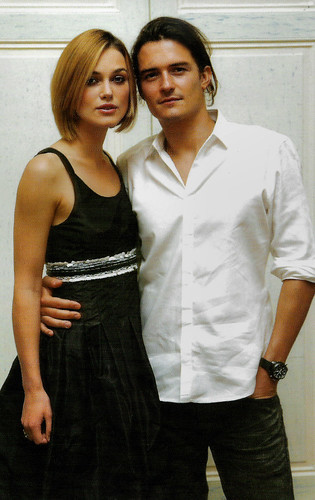
Vintage postcard by Idoles. With Orlando Bloom .
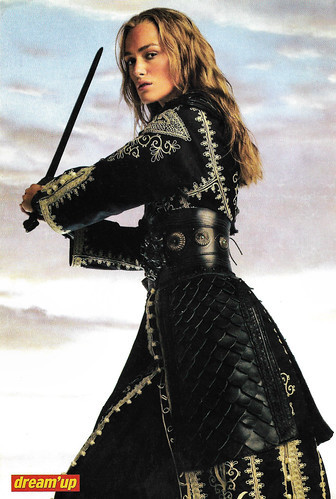
French postcard by Dream'up. Keira Knightley in Pirates of the Caribbean: At World's End (Gore Verbinski, 2007).
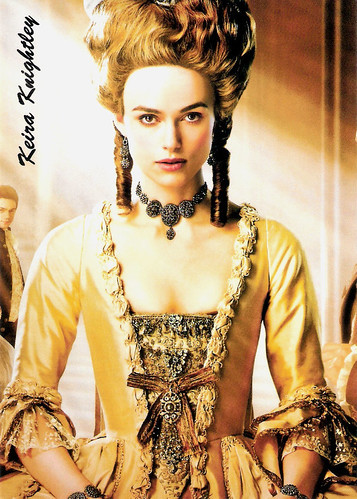
Vintage postcard. Keira Knightley in The Duchess (Saul Dibb, 2008).
Sources: Alexander Larman (BFI Screenonline), Jason Buchanan (AllMovie), Wikipedia (English and Dutch), and .

Vintage postcard. Keira Knightley in King Arthur (Antoine Fuqua, 2004). Knightley's first name is misspelled here as Kiara.

Chinese postcard by Oriental City Publishing Group Limited.

Vintage postcard by Idoles. Photo: Walt Disney Pictures. Keira Knightley in Pirates of the Caribbean - Dead Man's Chest (Gore Verbinski, 2006).
A tomboy football player struggling against social norms
Keira Christina Righton-Knightley OBE was born in 1985 in London to stage actor Will Knightley and acclaimed playwright Sharman Macdonald. Knightley has an older brother, Caleb. Keira attended Teddington School.
At age six, she obtained an agent and initially acted in commercials and television films. She focused on art, history, and English literature while studying at Esher College, but left after a year to pursue an acting career.
On TV, Keira played Natasha Jordan, a young girl whose mother (Sophie Ward) is involved in an extramarital affair, in the romantic drama A Village Affair (Moira Armstrong, 1995). She showed unusually artistic tastes in her early roles, playing the young Gabrielle Anwar in Innocent Lies (Patrick DeWolf, 1995) and the youthful Emily Mortimer in the Rosamund Pilcher TV adaptation Coming Home (Giles Foster, 1998).
In the cinema, she appeared as Sabé, Queen Padmé Amidala's (Natalie Portman) handmaiden and decoy, in the Science-Fiction blockbuster Star Wars: Episode I – The Phantom Menace (George Lucas, 1999). Her resemblance to Portman at the time was such that her appearance during the promotion of the film was kept a secret. Outwardly, it was maintained that Portman played both Amidala and Sabé.
Her first major role, she had in the Walt Disney Productions TV film Princess of Thieves (Peter Hewitt, 2001). Knightley played the daughter of Robin Hood. Concurrently, she appeared in The Hole (Nick Hamm, 2001), a thriller that received a direct-to-video release in the US.
Despite having appeared in over a dozen film and television roles, Knightley struggled to get a breakthrough until portraying a tomboy soccer player in the British sports film Bend It Like Beckham (Gurinder Chadha, 2001), co-starring Parminder Nagra and Jonathan Rhys Meyers. Knightley portrayed Jules, a tomboy football player struggling against social norms who convinces her friend to pursue the sport. The film was a surprise critical and commercial success with a gross of $76.6 million at the box office.
As Lara Antipova in the TV miniseries Doctor Zhivago (Giacomo Campiotti, 2002), Knightley gracefully slipped into a role that was previously made famous by Julie Christie , and the timeless romantic drama proved a hit with British television viewers.
Knightley achieved global stardom at age 18 when she portrayed the role of Elizabeth Swann opposite Orlando Bloom and Johnny Depp in the fantastic Swashbuckler Pirates of the Caribbean: The Curse of the Black Pearl (Gore Verbinski, 2003).
"Her debut Hollywood film, writes Alexander Larman at Screenonline, "allowed her to look fetching while battling undead pirates, but she remained subsidiary to Johnny Depp 's grandstanding hamming - though not enough to prevent her being cast in the two sequels." The film opened at number one on the box office, and became one of the highest-grossing releases of the year, with worldwide revenues of $654 million.
In the same year, she played a cameo in the Christmas romantic comedy Love Actually (Richard Curtis, 2003) alongside some of the best-known British film actors of the time including Alan Rickman, Hugh Grant , Emma Thompson, Liam Neeson, Rowan Atkinson, and Colin Firth. It became another box-office success, grossing $246 million worldwide on a budget of $40–45 million. Frequently shown during the Christmas season, the film has proved more popular with audiences than critics, and it has been discussed as being arguably a modern-day Christmas staple.

French postcard by Sonis, no. C. 1705. Photo: Disney. Keira Knightley in Pirates of the Caribbean - Dead Man's Chest (Gore Verbinski, 2006).

British postcard by Arcards, no. 0842. Photo: Walt Disney Pictures. Keira Knightley in Pirates of the Caribbean - Dead Man's Chest (Gore Verbinski, 2006).

Vintage postcard. Keira Knightley in Pirates of the Caribbean: At World's End (Gore Verbinski, 2007).

Belgian postcard by Nieuwsblad.be. Keira Knightley in Pirates of the Caribbean: At World's End (Gore Verbinski, 2007).
Elizabeth Bennet and Elizabeth Swann
Keira Knightley gave a feisty performance as Guinevere in King Arthur (Antoine Fuqua, 2004) opposite Clive Owen and Ioan Gruffudd. It reinforced her credentials as a contemporary action heroine. Then she portrayed Elizabeth Bennet in an adaption of Jane Austen's Pride & Prejudice (Joe Wright, 2005), which earned Knightley her first Golden Globe and Oscar nominations. At age 20, she became the second-youngest Best Actress nominee.
In 2006, she reprised her role as Elizabeth Swann in the second and third productions of the Pirates of the Caribbean series, Pirates of the Caribbean: Dead Man's Chest (Gore Verbinski, 2006) and Pirates of the Caribbean: At World's End (Gore Verbinski, 2007).
Knightley then starred in a series of further period pieces, portraying a complex love interest in Atonement (Joe Wright, 2007) with James McAvoy, tastemaker Georgiana Cavendish in The Duchess (Saul Dibb, 2008), and the titular socialite in Anna Karenina (Joe Wright, 2012).
She then forayed into contemporary dramas, appearing as an aspiring musician in Begin Again (John Carney, 2013) and a medical student in the spy thriller Jack Ryan: Shadow Recruit (Kenneth Branagh, 2014), starring Chris Pine. Knightley returned to historical films by playing Joan Clarke, a woman who helped crack German codes during WWII, in The Imitation Game (Morten Tyldum, 2014), earning her a second round of Academy Award and BAFTA nominations, and by starring as the eponymous belle époque writer in Colette (Wash Westmoreland, 2018) to critical acclaim.
Knightley reprised the role of Elizabeth Swann with a cameo appearance in Pirates of the Caribbean: Dead Men Tell No Tales (Joachim Rønning, Espen Sandberg, 2017) after test audiences repeatedly inquired about her character. On stage, she has appeared in two West End productions: Molière's comedy 'The Misanthrope' in 2009, which earned her an Olivier Award nomination, and 'The Children's Hour' by Lillian Hellman in 2011. She also starred as the eponymous heroine in the 2015 Broadway production of Émile Zola's 'Thérèse Raquin.
Keira Knightley is known for her outspoken stance on social issues and has worked extensively with Amnesty International, Oxfam, and Comic Relief. Knightley was in a relationship with her Pride and Prejudice counterpart Rupert Friend for five years. She married musician James Righton in 2013; they have two children.
Knightley's first role of the new decade was feminist activist Sally Alexander in Misbehaviour (Philippa Lowthorpe, 2020), a British comedy-drama about the crowning of the first black contestant at the 1970 Miss World competition. Knightley is set to star in the upcoming holiday comedy Silent Night, written and directed by Camille Griffin.

Vintage postcard by Idoles. With Orlando Bloom .

French postcard by Dream'up. Keira Knightley in Pirates of the Caribbean: At World's End (Gore Verbinski, 2007).

Vintage postcard. Keira Knightley in The Duchess (Saul Dibb, 2008).
Sources: Alexander Larman (BFI Screenonline), Jason Buchanan (AllMovie), Wikipedia (English and Dutch), and .
Published on August 26, 2021 22:00
August 25, 2021
The Rolling Stones: Charlie Watts (1941-2021)
Last Tuesday, 24 August 2021, Charlie Watts (1941-2021), the drummer for the Rolling Stones, passed away. He was one of the band's longest-serving members, joining in January 1963 and remaining a member until his death in 2021. Watts cited jazz as a major influence on his drumming style. The Rolling Stones is a legendary English rock band known for such hits as 'Paint it Black', 'Lady Jane', 'Ruby Tuesday', and '(I Can't Get No) Satisfaction'. The band and notably singer Mick Jagger appeared in several films.
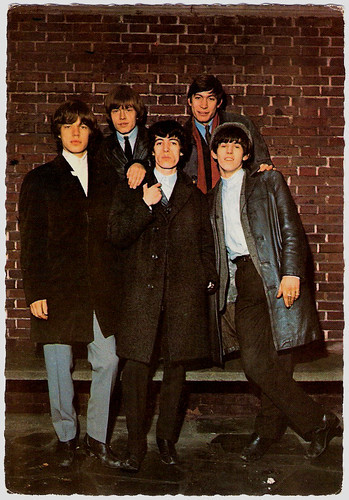
French postcard by PSG / Korès, no. 445. The Rolling Stones, with Charlie Watts right above.
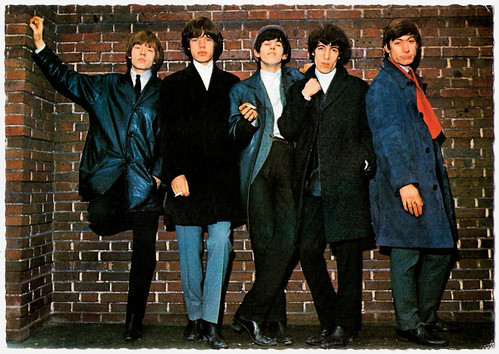
French postcard by PSG, no. 446. The Rolling Stones. Charlie Watts is on the far right.
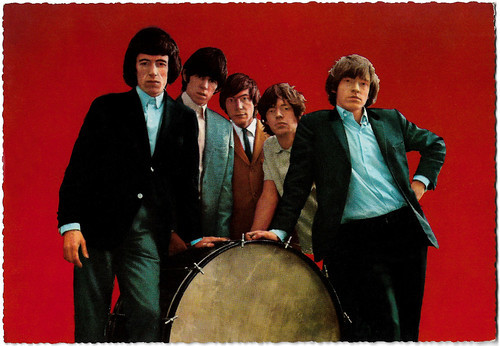
West-German postcard by Krüger, no. 902/315. Photo: Michael Lyons. The Rolling Stones with Charlie Watts in the middle.
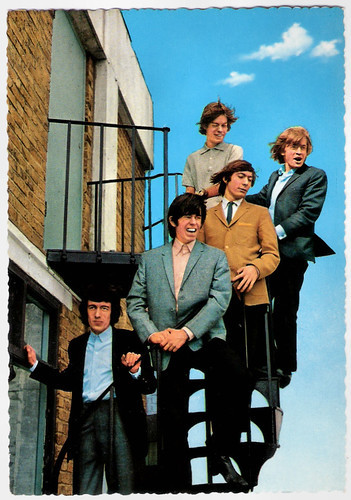
West-German postcard by Krüger, no. 902/316. Photo: Michael Lyons. The Rolling Stones. Charlie Watts is in the middle.
The British invasion
The Rolling Stones was formed in 1962 in London when original leader Brian Jones and pianist Ian Stewart were joined by singer Mick Jagger and guitarist Keith Richards, whose songwriting partnership later contributed to their taking the leadership role in the group.
Bassist Bill Wyman and drummer Charlie Watts completed the early line-up. Ian Stewart was removed from the official line-up in 1963 but continued to work with the band as road manager and keyboardist until his death in 1985.
The band's early recordings were mainly covers of American blues and R&B songs. After first achieving success in the UK, they became popular in the US during the ‘British Invasion’ of the early 1960s.
Their 1965 single '(I Can't Get No) Satisfaction' established The Rolling Stones as a premier rock and roll act. It was composed by Keith Richards in his sleep, and with the addition of provocative lyrics by Mick Jagger, it became their greatest hit.
During 1966-1969 they toured the world and constantly updated their song-list with great hits like 'Let's Spend the night together' (1967), 'Sympathy for the Devil' (1968), and 'Honky Tonk Woman' (1969).
The rehearsal and recording of 'Sympathy for the Devil' were filmed by Jean Luc Godard, who used it in his satirical collage of rock documentary and political commentary, One Plus One/Sympathy for the Devil (Jean-Luc Godard, 1968).
The following year the first concert film of the Stones was released: The Stones in the Park (Leslie Woodhead, 1969).
It was followed by the harrowing documentary Gimme Shelter (Albert & David Maysles, 1970). In December of 1969, four months after Woodstock, the Rolling Stones, and Jefferson Airplane gave a free concert in Northern California, east of Oakland at Altamont Speedway. About 300,000 people came, and the organizers put Hell's Angels in charge of security around the stage. Armed with pool cues and knives, Angels spent the concert beating up spectators, killing at least one.
Cocksucker Blues (1972) was a film by photographer Robert Frank on the 1972 American tour. The film was not released by the Stones reportedly because it contained scenes of drug use and groupie orgies.
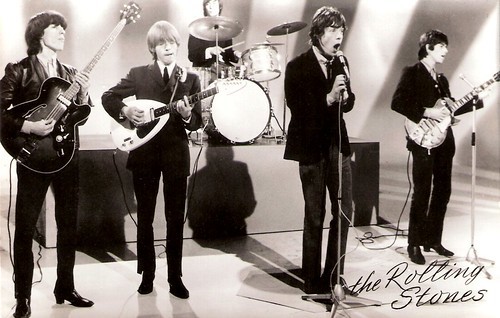
Dutch postcard by 't Sticht, Utrecht, no. AX 6302.
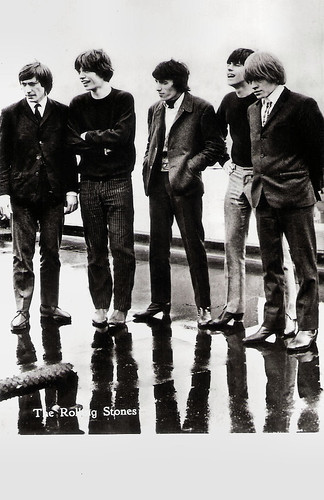
Dutch postcard.

Dutch postcard by 't Sticht, Utrecht, no. AX 1187.
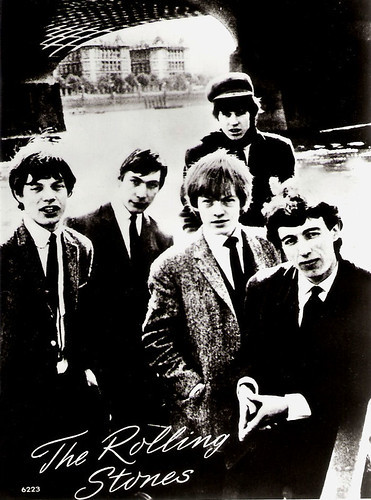
Dutch postcard, no. 6223.
It's only rock and roll
In 1969, Brian Jones died shortly after being fired from the band. He was replaced by Mick Taylor.
At the end of the 1960s, the creativity of The Rolling Stones reached new highs. Their albums 'Beggars Banquet' (1968) and 'Sticky Fingers' (1971) were among the most popular albums they ever made. They had hits as 'Wild Horses' and 'Brown Sugar'.
During the 1970s, the Rolling Stones remained the biggest band in the world. In 1974 former Faces guitarist Ronnie Wood replaced Mick Taylor. Wood has been with the band ever since.
The Stones made thousands of live performances and multi-million record sales with hits like 'Angie' (1973), 'It's Only Rock and Roll' (1974), 'Hot Stuff' (1976), and 'Respectable' (1978).
At that time both Keith Richards and Mick Jagger had individual ambitions and applied their untamed creativity in various projects outside the Stones.
Wyman left the Rolling Stones in 1993. Bassist Darryl Jones, who is not an official band member, has worked with the group since 1994. The Rolling Stones have sold more than 200 million albums worldwide.

French postcard by PSG, no. 1189, offered by Corvisart, Epinal. Photo: Decca.
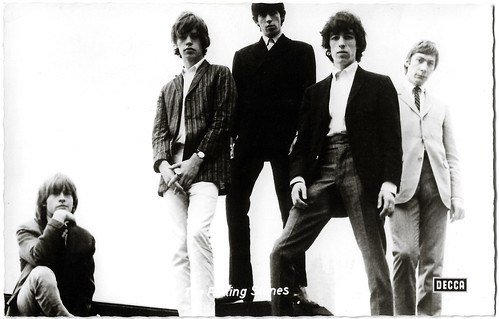
West-German Kolibri postcard by Friedrich-W. Sander-Verlag, Minden/Westf, no. 2474. Photo: Teldec / Decca London. The Rolling Stones, with Charlie Watts on the far right.

Italian postcard by Silvercart, Milano, no. 516/7.
A challenge to respectable standards
Mick Jagger (1943) has been called "the heart of The Stones" and Keith Richards (1943) "the soul".
Jagger dropped out of college and never received a formal musical education, and even could not read music. Every move of Jagger on-stage and off-stage seemed to signal a challenge to respectable standards. The public loved it.
Jagger worked hard and emerged as the lead singer and songwriter in partnership with Richards, following the example of John Lennon and Paul McCartney 's songwriting for The Beatles .
Mick Jagger also starred in several films, such as Performance (Nicolas Roeg, Donald Cammell, 1970), Ned Kelly (Tony Richardson, 1970), Running Out of Luck (Julien Temple, 1987), Freejack (Geoff Murphy, 1992), Bent (Sean Mathias, 1997), and The Man from Elysian Fields (George Hickenlooper, 2001).
Keith Richards was a schoolmate of Jagger since primary school. In 1960 they contemplated starting up a band together. Since the formation of the Rolling Stones in 1962, Richards has been the principal songwriting partner with Jagger, and most of the songs on all Rolling Stones albums are credited to Jagger/Richards.
Besides his music career, Richards made a cameo appearance as Captain Teague, the father of Jack Sparrow ( Johnny Depp ) in Pirates of the Caribbean: At World's End (Gore Verbinski, 2007).
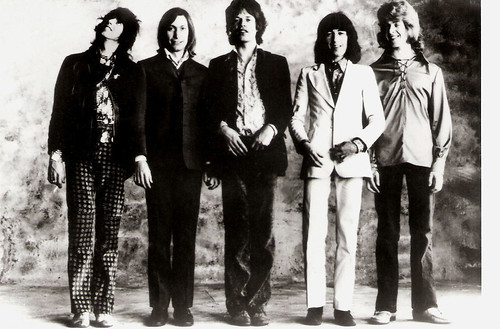
Dutch postcard.
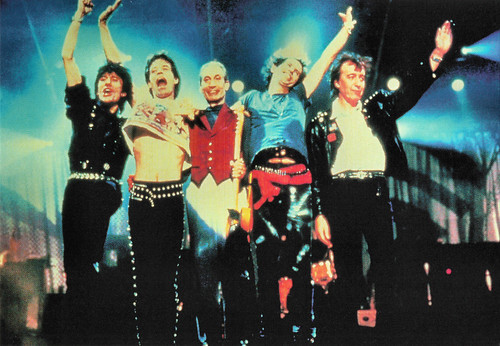
British postcard by Go Card. Photo: Rolling Stones at the Max. Caption: A 90-minute IMAX concert experience! Charlie Watts is in the middle.
50 & Counting
In 2008 the Rolling Stones united with legendary director Martin Scorsese for Shine A Light (2008). For this career-spanning documentary, Scorsese used concert footage from their A Bigger Bang tour and he filmed the Stones over a two-day period at the intimate Beacon Theatre in New York City in the fall of 2006. In between, there are some short clips of old Stones interviews and some Behind-the-Scenes-Footage.
It was followed by The Stones in Exile (Stephen Kijak, 2010). This documentary gives a look at the creation and impact of the 1972 Rolling Stones album Exile on Main St.
The Rolling Stones celebrated their 50th anniversary in the summer of 2012 by releasing a large hardback book titled '50'. It was followed by a documentary titled Crossfire Hurricane (Brett Morgen, 2012). Approximately fifty hours of interviews were conducted by Morgen for use for the documentary, including interviews with Bill Wyman and Mick Taylor.
In November 2012, the Stones started their 50 & Counting tour, which kept them busy throughout 2013. It was followed by a live DVD, Sweet Summer Sun: Live in Hyde Park (2013). In 2027 followed the No Filter Tour. From Wyman's departure in 1993 to Watts' death in 2021, the band continued as a four-piece core, with Darryl Jones playing bass on tour and on most studio recordings.
Trailer for Sympathy For The Devil (1968). Source: ABKCO Records & Films (YouTube).
Trailer for Gimme Shelter (1970). Source: HD Retro Trailers (YouTube).
Trailer for Performance (1970). Source: Warner Bros. (YouTube).
Trailer for Bent (1997). Source: LGBT MONEY (YouTube).
Trailer for the documentary Shine A Light (2008), directed by Martin Scorsese. Source: VidereTrailer (YouTube).
Trailer for The Stones in Exile (2010). Source: Mercury Studios (YouTube).
Sources: (IMDb), Wikipedia, and .

French postcard by PSG / Korès, no. 445. The Rolling Stones, with Charlie Watts right above.

French postcard by PSG, no. 446. The Rolling Stones. Charlie Watts is on the far right.

West-German postcard by Krüger, no. 902/315. Photo: Michael Lyons. The Rolling Stones with Charlie Watts in the middle.

West-German postcard by Krüger, no. 902/316. Photo: Michael Lyons. The Rolling Stones. Charlie Watts is in the middle.
The British invasion
The Rolling Stones was formed in 1962 in London when original leader Brian Jones and pianist Ian Stewart were joined by singer Mick Jagger and guitarist Keith Richards, whose songwriting partnership later contributed to their taking the leadership role in the group.
Bassist Bill Wyman and drummer Charlie Watts completed the early line-up. Ian Stewart was removed from the official line-up in 1963 but continued to work with the band as road manager and keyboardist until his death in 1985.
The band's early recordings were mainly covers of American blues and R&B songs. After first achieving success in the UK, they became popular in the US during the ‘British Invasion’ of the early 1960s.
Their 1965 single '(I Can't Get No) Satisfaction' established The Rolling Stones as a premier rock and roll act. It was composed by Keith Richards in his sleep, and with the addition of provocative lyrics by Mick Jagger, it became their greatest hit.
During 1966-1969 they toured the world and constantly updated their song-list with great hits like 'Let's Spend the night together' (1967), 'Sympathy for the Devil' (1968), and 'Honky Tonk Woman' (1969).
The rehearsal and recording of 'Sympathy for the Devil' were filmed by Jean Luc Godard, who used it in his satirical collage of rock documentary and political commentary, One Plus One/Sympathy for the Devil (Jean-Luc Godard, 1968).
The following year the first concert film of the Stones was released: The Stones in the Park (Leslie Woodhead, 1969).
It was followed by the harrowing documentary Gimme Shelter (Albert & David Maysles, 1970). In December of 1969, four months after Woodstock, the Rolling Stones, and Jefferson Airplane gave a free concert in Northern California, east of Oakland at Altamont Speedway. About 300,000 people came, and the organizers put Hell's Angels in charge of security around the stage. Armed with pool cues and knives, Angels spent the concert beating up spectators, killing at least one.
Cocksucker Blues (1972) was a film by photographer Robert Frank on the 1972 American tour. The film was not released by the Stones reportedly because it contained scenes of drug use and groupie orgies.

Dutch postcard by 't Sticht, Utrecht, no. AX 6302.

Dutch postcard.

Dutch postcard by 't Sticht, Utrecht, no. AX 1187.

Dutch postcard, no. 6223.
It's only rock and roll
In 1969, Brian Jones died shortly after being fired from the band. He was replaced by Mick Taylor.
At the end of the 1960s, the creativity of The Rolling Stones reached new highs. Their albums 'Beggars Banquet' (1968) and 'Sticky Fingers' (1971) were among the most popular albums they ever made. They had hits as 'Wild Horses' and 'Brown Sugar'.
During the 1970s, the Rolling Stones remained the biggest band in the world. In 1974 former Faces guitarist Ronnie Wood replaced Mick Taylor. Wood has been with the band ever since.
The Stones made thousands of live performances and multi-million record sales with hits like 'Angie' (1973), 'It's Only Rock and Roll' (1974), 'Hot Stuff' (1976), and 'Respectable' (1978).
At that time both Keith Richards and Mick Jagger had individual ambitions and applied their untamed creativity in various projects outside the Stones.
Wyman left the Rolling Stones in 1993. Bassist Darryl Jones, who is not an official band member, has worked with the group since 1994. The Rolling Stones have sold more than 200 million albums worldwide.

French postcard by PSG, no. 1189, offered by Corvisart, Epinal. Photo: Decca.

West-German Kolibri postcard by Friedrich-W. Sander-Verlag, Minden/Westf, no. 2474. Photo: Teldec / Decca London. The Rolling Stones, with Charlie Watts on the far right.

Italian postcard by Silvercart, Milano, no. 516/7.
A challenge to respectable standards
Mick Jagger (1943) has been called "the heart of The Stones" and Keith Richards (1943) "the soul".
Jagger dropped out of college and never received a formal musical education, and even could not read music. Every move of Jagger on-stage and off-stage seemed to signal a challenge to respectable standards. The public loved it.
Jagger worked hard and emerged as the lead singer and songwriter in partnership with Richards, following the example of John Lennon and Paul McCartney 's songwriting for The Beatles .
Mick Jagger also starred in several films, such as Performance (Nicolas Roeg, Donald Cammell, 1970), Ned Kelly (Tony Richardson, 1970), Running Out of Luck (Julien Temple, 1987), Freejack (Geoff Murphy, 1992), Bent (Sean Mathias, 1997), and The Man from Elysian Fields (George Hickenlooper, 2001).
Keith Richards was a schoolmate of Jagger since primary school. In 1960 they contemplated starting up a band together. Since the formation of the Rolling Stones in 1962, Richards has been the principal songwriting partner with Jagger, and most of the songs on all Rolling Stones albums are credited to Jagger/Richards.
Besides his music career, Richards made a cameo appearance as Captain Teague, the father of Jack Sparrow ( Johnny Depp ) in Pirates of the Caribbean: At World's End (Gore Verbinski, 2007).

Dutch postcard.

British postcard by Go Card. Photo: Rolling Stones at the Max. Caption: A 90-minute IMAX concert experience! Charlie Watts is in the middle.
50 & Counting
In 2008 the Rolling Stones united with legendary director Martin Scorsese for Shine A Light (2008). For this career-spanning documentary, Scorsese used concert footage from their A Bigger Bang tour and he filmed the Stones over a two-day period at the intimate Beacon Theatre in New York City in the fall of 2006. In between, there are some short clips of old Stones interviews and some Behind-the-Scenes-Footage.
It was followed by The Stones in Exile (Stephen Kijak, 2010). This documentary gives a look at the creation and impact of the 1972 Rolling Stones album Exile on Main St.
The Rolling Stones celebrated their 50th anniversary in the summer of 2012 by releasing a large hardback book titled '50'. It was followed by a documentary titled Crossfire Hurricane (Brett Morgen, 2012). Approximately fifty hours of interviews were conducted by Morgen for use for the documentary, including interviews with Bill Wyman and Mick Taylor.
In November 2012, the Stones started their 50 & Counting tour, which kept them busy throughout 2013. It was followed by a live DVD, Sweet Summer Sun: Live in Hyde Park (2013). In 2027 followed the No Filter Tour. From Wyman's departure in 1993 to Watts' death in 2021, the band continued as a four-piece core, with Darryl Jones playing bass on tour and on most studio recordings.
Trailer for Sympathy For The Devil (1968). Source: ABKCO Records & Films (YouTube).
Trailer for Gimme Shelter (1970). Source: HD Retro Trailers (YouTube).
Trailer for Performance (1970). Source: Warner Bros. (YouTube).
Trailer for Bent (1997). Source: LGBT MONEY (YouTube).
Trailer for the documentary Shine A Light (2008), directed by Martin Scorsese. Source: VidereTrailer (YouTube).
Trailer for The Stones in Exile (2010). Source: Mercury Studios (YouTube).
Sources: (IMDb), Wikipedia, and .
Published on August 25, 2021 22:00
August 24, 2021
Erno Crisa
Erno Crisa (1914-1968) was a handsome Italian actor, who appeared in a long series of films during the 1950s and 1960s.
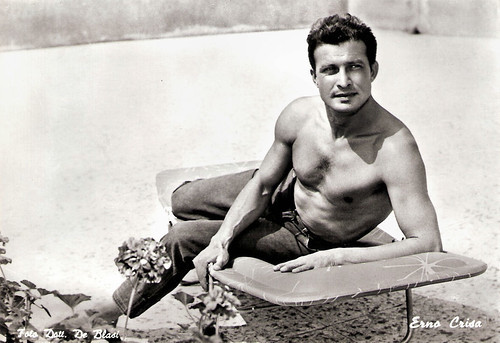
Italian postcard by Bromofoto, Milano, no. 1434. Photo: Dott. De Blasi.

Italian postcard by Bromofoto, Milano, no. 1034. Erno Crisa in L'amant de lady Chatterley/Lady Chatterley's Lover (Marc Allégret, 1955).
Ballet and modern and classical choreography
Erno Crisa was born Ernesto Crisà in 1914 in Biserta, Tunisia, into a family of Sicilian emigrants.
Fascinated by the world of show business, after emigrating to France he attended Preobajenska's courses in ballet and modern and classical choreography, later managing to work in some Parisian theatre productions.
In 1945, after a few uncredited bit parts, he made his debut in French cinema as a vagabond opposite Fernandel in the comedy Le mystère Saint-Val/St. Val's Mystery (René Le Hénaff, 1945). Fernandel 's first film following the liberation of Paris was a big hit in France.
He also appeared in Le jugement dernier/The Last Judgment (René Chanas, 1945), a French film drama starring Raymond Bussières. He returned to Italy, where he was recruited by Wanda Osiris' company. There he worked as a ballet soloist in Garinei and Giovannini's revue 'Al Grand Hotel' in the 1948-1949 season.

Italian postcard by B.F.F. Edit., no. 2779. Photo: Minerva Films.
Peplum muscleman
In 1950 Erno Crisa was noticed by director Luigi Zampa, who asked him to play a role in the drama Cuori senza frontiere/The White Line (1950), starring Raf Vallone and Gina Lollobrigida . This was the beginning of a long series of films that he would make until the end of the 1960s. He also appeared in many Foto romanzi, the Italian photo novels, including the infamous Killing (aka Sadistik).
Memorable titles of the fifties in which he had leads were e.g. Gelosia/Jealousy (Pietro Germi, 1953), Violenza sul lago/Violence in the lake (Leonardo Cortese, 1954) with Lia Amanda, La figlia di Mata Hari/Mata Hari's Daughter (Renzo Merusi, Carmine Gallone, 1954) starring Ludmilla Tchérina , the French drama L'amant de lady Chatterley/Lady Chatterley's Lover (Marc Allégret, 1955) opposite Danielle Darrieux , and I mafiosi/The mafia (Roberto Mauri, 1959).
In addition, Crisa had supporting parts in modern dramas, period pieces, and Musicarellos. In the early 1960s, Crisa acted in several Peplums like Cartagine in fiamme/Carthage in Flames (Carmine Gallone, 1960) starring Pierre Brasseur , and other historical or mythological films with musclemen like Ed Fury, Gordon Mitchell, and Mark Forest.
He appeared in one episode of the Angelique series starring Michèle Mercier , Angélique et le Sultan/Angelique and the Sultan (Bernard Borderie, 1968), and played the inspector in the crime thriller Plein soleil/Purple Noon (René Clement, 1960) starring Alain Delon . He also appeared in such Spaghetti Westerns as Sugar Colt (Franco Giraldi, 1966), credited as James Parker.
In 1968, Erno Crisa suddenly died in Rome at the age of 54. He is buried in the cemetery of Casalpusterlengo, near Lodi, next to his wife Giuseppina Ferri.
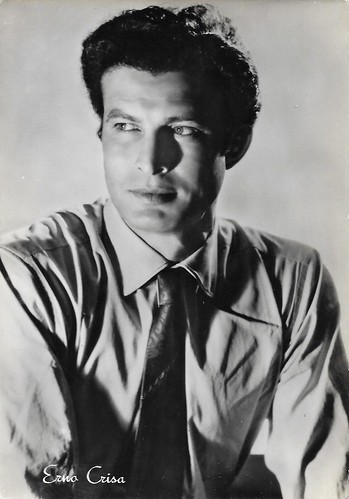
Italian postcard by Rotalfoto, Milano, no. 356.
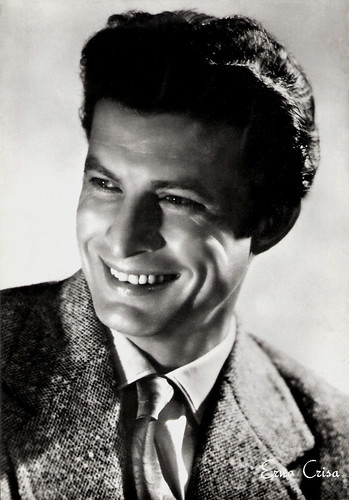
Italian postcard by Rotalfoto, Milano, no. 405.
Sources: Wikipedia (Italian and English) and .

Italian postcard by Bromofoto, Milano, no. 1434. Photo: Dott. De Blasi.

Italian postcard by Bromofoto, Milano, no. 1034. Erno Crisa in L'amant de lady Chatterley/Lady Chatterley's Lover (Marc Allégret, 1955).
Ballet and modern and classical choreography
Erno Crisa was born Ernesto Crisà in 1914 in Biserta, Tunisia, into a family of Sicilian emigrants.
Fascinated by the world of show business, after emigrating to France he attended Preobajenska's courses in ballet and modern and classical choreography, later managing to work in some Parisian theatre productions.
In 1945, after a few uncredited bit parts, he made his debut in French cinema as a vagabond opposite Fernandel in the comedy Le mystère Saint-Val/St. Val's Mystery (René Le Hénaff, 1945). Fernandel 's first film following the liberation of Paris was a big hit in France.
He also appeared in Le jugement dernier/The Last Judgment (René Chanas, 1945), a French film drama starring Raymond Bussières. He returned to Italy, where he was recruited by Wanda Osiris' company. There he worked as a ballet soloist in Garinei and Giovannini's revue 'Al Grand Hotel' in the 1948-1949 season.

Italian postcard by B.F.F. Edit., no. 2779. Photo: Minerva Films.
Peplum muscleman
In 1950 Erno Crisa was noticed by director Luigi Zampa, who asked him to play a role in the drama Cuori senza frontiere/The White Line (1950), starring Raf Vallone and Gina Lollobrigida . This was the beginning of a long series of films that he would make until the end of the 1960s. He also appeared in many Foto romanzi, the Italian photo novels, including the infamous Killing (aka Sadistik).
Memorable titles of the fifties in which he had leads were e.g. Gelosia/Jealousy (Pietro Germi, 1953), Violenza sul lago/Violence in the lake (Leonardo Cortese, 1954) with Lia Amanda, La figlia di Mata Hari/Mata Hari's Daughter (Renzo Merusi, Carmine Gallone, 1954) starring Ludmilla Tchérina , the French drama L'amant de lady Chatterley/Lady Chatterley's Lover (Marc Allégret, 1955) opposite Danielle Darrieux , and I mafiosi/The mafia (Roberto Mauri, 1959).
In addition, Crisa had supporting parts in modern dramas, period pieces, and Musicarellos. In the early 1960s, Crisa acted in several Peplums like Cartagine in fiamme/Carthage in Flames (Carmine Gallone, 1960) starring Pierre Brasseur , and other historical or mythological films with musclemen like Ed Fury, Gordon Mitchell, and Mark Forest.
He appeared in one episode of the Angelique series starring Michèle Mercier , Angélique et le Sultan/Angelique and the Sultan (Bernard Borderie, 1968), and played the inspector in the crime thriller Plein soleil/Purple Noon (René Clement, 1960) starring Alain Delon . He also appeared in such Spaghetti Westerns as Sugar Colt (Franco Giraldi, 1966), credited as James Parker.
In 1968, Erno Crisa suddenly died in Rome at the age of 54. He is buried in the cemetery of Casalpusterlengo, near Lodi, next to his wife Giuseppina Ferri.

Italian postcard by Rotalfoto, Milano, no. 356.

Italian postcard by Rotalfoto, Milano, no. 405.
Sources: Wikipedia (Italian and English) and .
Published on August 24, 2021 22:00
August 23, 2021
Elena Solovey
(Y)Elena Solovey (1947) is a Russian-American film and stage actress, internationally best known for her films with director Nikita Mikhalkov during the 1970s and 1980. Later she emigrated to the USA, where she appeared in the TV series The Sopranos (2002) and several films by director James Gray. Since 1966, she appeared in 55 films.
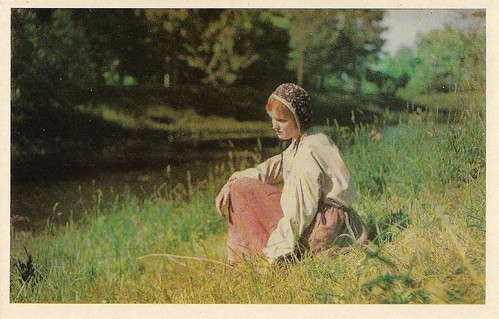
Soviet-Russian postcard. Photo: A. Manukyana / Lenfilm. Elena Solovey in Drama iz starinnoy zhizni/The Drama from Ancient Life (Ilya Averbakh, 1972).
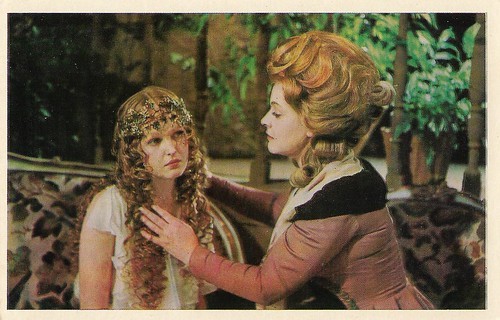
Soviet-Russian postcard. Photo: A. Manukyana / Lenfilm. Elena Solovey and Tatyana Piletskaya in Drama iz starinnoy zhizni/The Drama from Ancient Life (Ilya Averbakh, 1972).
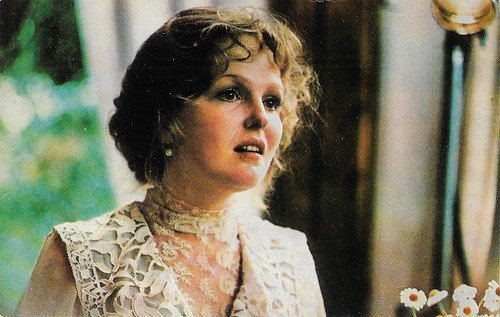
Soviet-Russian postcard by Leningradskoe otdenenie byuro propaganda sovetskogo kinoiskusstva. Photo: Mosfilm. Elena Solovey as Sophia in Neokonchennaya pyesa dlya mekhanicheskogo pianino/An Unfinished Piece for Mechanical Piano (Nikita Mikhalkov, 1977). The film was based on Anton Chekhov's 'Platonov', as well as several of his other short stories. In The Netherlands, the film was released at the time as Piano mécanique.
A dream of becoming an actress
Elena (also written as Yelena) Solovey was born Elena Yakovlevna Solovey in 1947, in Neustrelitz, East Germany. Her parents met in Berlin at the end of the Second World War. Her father, Yakov Solovey, was an artillery officer in the Red Army. Her mother was a medical nurse.
Young Elena lived in Germany until the age of 4, then moved to Novosibirsk, Siberian Russia, where her father continued his military career, then moved to Moscow. Elena had a dream of becoming an actress. She was fond of art, music, films, and theatre, and attended a music school in addition to her high school.
Eventually, she became a music teacher at a Moscow school, after failing to enter the Soviet State Institute of Cinema (VGIK). However, she was persistent and determined in pursuit of her dream, and a year later, she was admitted to VGIK, studied at the acting class of Boris Babochkin, graduating in 1970 as an actress.
Elena Solovey made her film debut in short films during the 1960s, while a VGIK student. In 1969 she played her first serious role as Clarice in Korol-olen/King Stag (1970) by director Pavel Arsyonov.
In 1970 she was invited to the troupe of Maly Theatre in Moscow. There Solovey was cast as Nina in 'The Seagull' by Anton Chekhov, albeit she followed her heart and married a Leningrad artist, Yuri Pugach, and the couple settled in Leningrad. There Solovey worked at Lenfilm Studios.
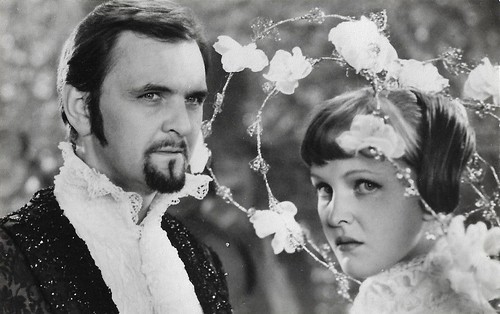
Soviet-Russian postcard, part of a series of black and white postcards on Elena Solovey, issued in 1984. Elena Solovey and Yuriy Yakovlev in Korol-olen/King Stag (Pavel Arsyonov, 1970).
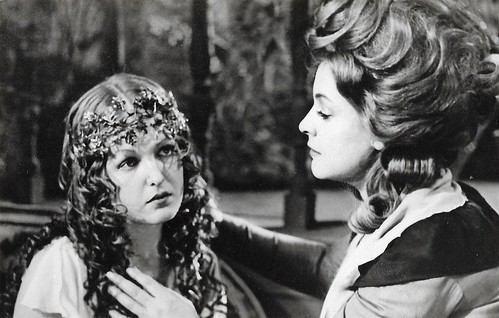
Soviet-Russian postcard, part of a series of black and white postcards on Elena Solovey, issued in 1984. Photo: A. Manukyana / Lenfilm. Elena Solovey and Tatyana Piletskaya in Drama iz starinnoy zhizni/The Drama from Ancient Life (Ilya Averbakh, 1972).
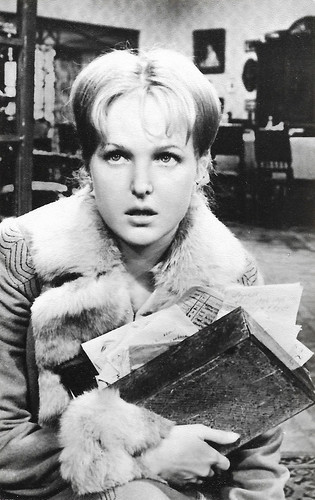
Soviet-Russian postcard, part of a series of black and white postcards on Elena Solovey, issued in 1984. Photo: Mosfilm. Elena Solovey in Deti Vanyushina/ Vanyushin's Children (Evgeniy Tashkov, 1974).
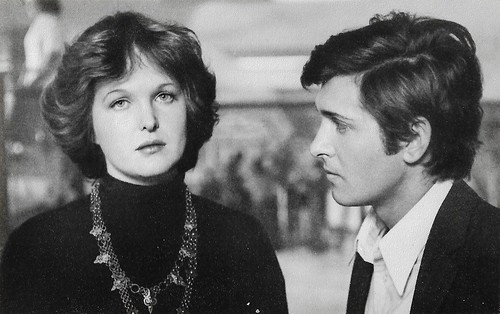
Soviet-Russian postcard, part of a series of black and white postcards on Elena Solovey, issued in 1984. Photo: Mosfilm. Elena Solovey and Sergey Martynov in Kontsert dlya dvukh skripok/Concerto for Two Violins (Ekaterina Stashevskaya-Naroditskaya, 1975).
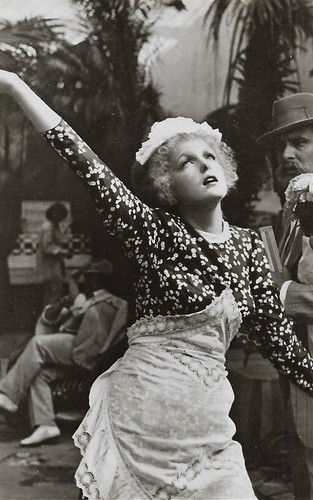
Soviet-Russian postcard, part of a series of black and white postcards on Elena Solovey, issued in 1984. Photo: Mosfilm. Elena Solovey in Raba lyubvi/Slave of Love (Nikita Mikhalkov, 1976).
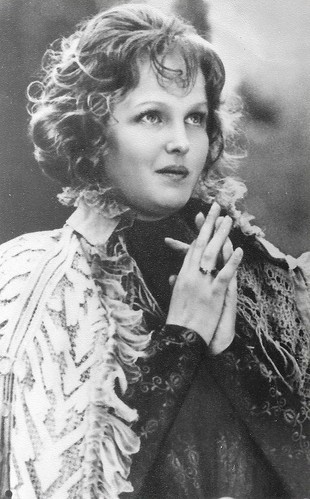
Soviet-Russian postcard, part of a series of black and white postcards on Elena Solovey, issued in 1984. Photo: Mosfilm. Elena Solovey as Sophia in Neokonchennaya pyesa dlya mekhanicheskogo pianino/An Unfinished Piece for Mechanical Piano (Nikita Mikhalkov, 1977).
Directed by Nikita Mikhalkov
During the 1970s Elena Solovey played her best-known roles. She had her international breakthrough as Olga Vosnesenskaya (alluding to 1910s film star Vera Kholodnaya ), opposite Rodion Nahapetov in Raba lyubvi/Slave of Love (1976). In 1918, at the height of the Bolshevik revolution, a small group of filmmakers are hurriedly trying to complete a silent melodrama while the world changes all around them. As production progresses, leading lady Elena Solovei metamorphoses from self-centered film star to committed revolutionary. With Slave of Love, director Nikita Mikhalkov gained his first serious international attention.
For Nikita Mikhalkov, Solovey also acted as Sofia opposite Aleksandr Kalyagin in Neokonchennaya pyesa dlya mekhanicheskogo pianino/An Unfinished Piece for Mechanical Piano (Nikita Mikhalkov, 1977), and as Olga opposite Oleg Tabakov in Neskolko dney iz zhizni I.I. Oblomova/Oblomov (Nikita Mikhalkov, 1980). In 1980 she received the award for best actress at the Oxford Film festival for Oblomov and in 1981 she won in Cannes the award for Best Supporting Actress for the Soviet-Lithuanian war film Faktas/Fakt/Fact (Almantas Grikevicius, 1981).
From 1983 till 1991 Elena Solovey was a member of the troupe at the Theatre of Lensoveta in St. Petersburg (Leningrad), Russia. There she appeared in leading and supporting roles in Russian and international stage production. Her last work on stage in St. Petersburg was the acclaimed production of 'Foto-finish' written and directed by Peter Ustinov. Ustinov cast Solovey as a co-star opposite Pyotr Shelokhonov as the male lead, supported by Anna Aleksakhina, Roman Gromadsky, and other notable Russian actors.
In the fall of 1991, Solovey emigrated from Russia and settled in New Jersey with her husband Yuri Pugach, two children, and a granddaughter. She appeared in Russian films, worked for Russian radio in New York, and played in several stage productions of 'Bluzhdayushcie zvezdy' (Wandering stars) troupe at the Russian area of Brighton Beach. In 2002 she played Branca Libinsk in three episodes of the TV series The Sopranos.
In 2007 she appeared in a supporting role as Kalina in We Own the Night (James Gray, 2007), a crime thriller about the Russian mafia starring Joaquin Phoenix, Mark Wahlberg, and Eva Mendes. She also appeared in the drama The Immigrant (James Gray, 1013), starring Marion Cotillard, Joaquin Phoenix, and Jeremy Renner, which was nominated for the Palme d'Or at the 2013 Cannes Film Festival. Her most recent film with writer-director James Gray was the biographical adventure drama The Lost City of Z (James Gray, 2016), starring Charlie Hunnam and Robert Pattinson.
Since the 1990s Elena Solovey has been teaching children of Russian emigrants at 'Etude' acting school in New Jersey, USA. In 1981, Elena Solovey was designated People's Actor of Russia.
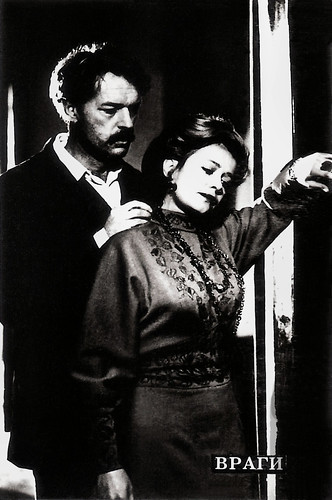
Soviet collectors card. Photo: Regimantas Adomaitis and Elena Solovey in Vragi/Enemies (Rodion Nahapetov, 1979).
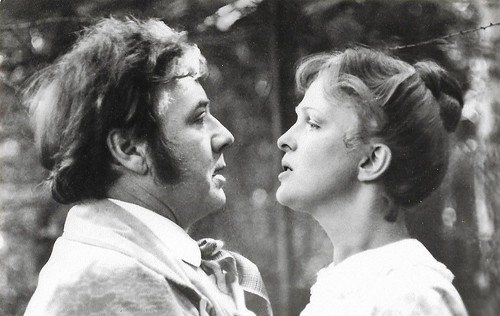
Soviet-Russian postcard, part of a series of black and white postcards on Elena Solovey, issued in 1984. Photo: Mosfilm. Elena Solovey and Oleg Tabakov in Neskolko dney iz zhizni I.I. Oblomova/Oblomov (Nikita Mikhalkov, 1980).
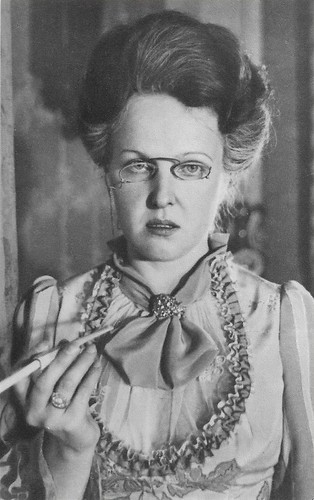
Soviet-Russian postcard, part of a series of black and white postcards on Elena Solovey, issued in 1984. Photo: Mosfilm. Elena Solovey in Beshenye dengi/Easy Money (Evgeniy Matveev, 1982).
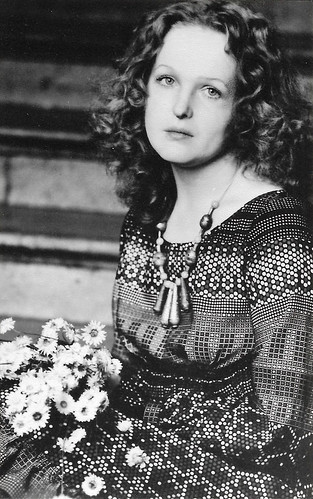
Soviet-Russian postcard, part of a series of black and white postcards on Elena Solovey, issued in 1984.
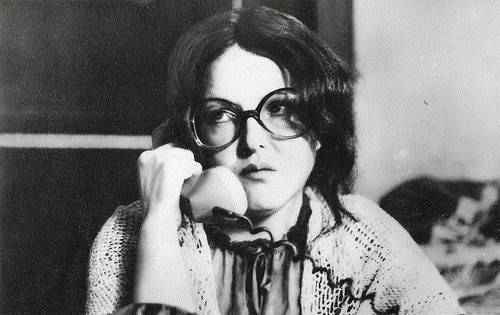
Soviet-Russian postcard, part of a series of black and white postcards on Elena Solovey, issued in 1984. Photo: Lenfilm. Elena Solovey in Blondinka za uglom/The Blonde Around the Corner (Vladimir Bortko, 1984).
Source: (IMDb), Hal Erickson (AllMovie), Wikipedia, and .

Soviet-Russian postcard. Photo: A. Manukyana / Lenfilm. Elena Solovey in Drama iz starinnoy zhizni/The Drama from Ancient Life (Ilya Averbakh, 1972).

Soviet-Russian postcard. Photo: A. Manukyana / Lenfilm. Elena Solovey and Tatyana Piletskaya in Drama iz starinnoy zhizni/The Drama from Ancient Life (Ilya Averbakh, 1972).

Soviet-Russian postcard by Leningradskoe otdenenie byuro propaganda sovetskogo kinoiskusstva. Photo: Mosfilm. Elena Solovey as Sophia in Neokonchennaya pyesa dlya mekhanicheskogo pianino/An Unfinished Piece for Mechanical Piano (Nikita Mikhalkov, 1977). The film was based on Anton Chekhov's 'Platonov', as well as several of his other short stories. In The Netherlands, the film was released at the time as Piano mécanique.
A dream of becoming an actress
Elena (also written as Yelena) Solovey was born Elena Yakovlevna Solovey in 1947, in Neustrelitz, East Germany. Her parents met in Berlin at the end of the Second World War. Her father, Yakov Solovey, was an artillery officer in the Red Army. Her mother was a medical nurse.
Young Elena lived in Germany until the age of 4, then moved to Novosibirsk, Siberian Russia, where her father continued his military career, then moved to Moscow. Elena had a dream of becoming an actress. She was fond of art, music, films, and theatre, and attended a music school in addition to her high school.
Eventually, she became a music teacher at a Moscow school, after failing to enter the Soviet State Institute of Cinema (VGIK). However, she was persistent and determined in pursuit of her dream, and a year later, she was admitted to VGIK, studied at the acting class of Boris Babochkin, graduating in 1970 as an actress.
Elena Solovey made her film debut in short films during the 1960s, while a VGIK student. In 1969 she played her first serious role as Clarice in Korol-olen/King Stag (1970) by director Pavel Arsyonov.
In 1970 she was invited to the troupe of Maly Theatre in Moscow. There Solovey was cast as Nina in 'The Seagull' by Anton Chekhov, albeit she followed her heart and married a Leningrad artist, Yuri Pugach, and the couple settled in Leningrad. There Solovey worked at Lenfilm Studios.

Soviet-Russian postcard, part of a series of black and white postcards on Elena Solovey, issued in 1984. Elena Solovey and Yuriy Yakovlev in Korol-olen/King Stag (Pavel Arsyonov, 1970).

Soviet-Russian postcard, part of a series of black and white postcards on Elena Solovey, issued in 1984. Photo: A. Manukyana / Lenfilm. Elena Solovey and Tatyana Piletskaya in Drama iz starinnoy zhizni/The Drama from Ancient Life (Ilya Averbakh, 1972).

Soviet-Russian postcard, part of a series of black and white postcards on Elena Solovey, issued in 1984. Photo: Mosfilm. Elena Solovey in Deti Vanyushina/ Vanyushin's Children (Evgeniy Tashkov, 1974).

Soviet-Russian postcard, part of a series of black and white postcards on Elena Solovey, issued in 1984. Photo: Mosfilm. Elena Solovey and Sergey Martynov in Kontsert dlya dvukh skripok/Concerto for Two Violins (Ekaterina Stashevskaya-Naroditskaya, 1975).

Soviet-Russian postcard, part of a series of black and white postcards on Elena Solovey, issued in 1984. Photo: Mosfilm. Elena Solovey in Raba lyubvi/Slave of Love (Nikita Mikhalkov, 1976).

Soviet-Russian postcard, part of a series of black and white postcards on Elena Solovey, issued in 1984. Photo: Mosfilm. Elena Solovey as Sophia in Neokonchennaya pyesa dlya mekhanicheskogo pianino/An Unfinished Piece for Mechanical Piano (Nikita Mikhalkov, 1977).
Directed by Nikita Mikhalkov
During the 1970s Elena Solovey played her best-known roles. She had her international breakthrough as Olga Vosnesenskaya (alluding to 1910s film star Vera Kholodnaya ), opposite Rodion Nahapetov in Raba lyubvi/Slave of Love (1976). In 1918, at the height of the Bolshevik revolution, a small group of filmmakers are hurriedly trying to complete a silent melodrama while the world changes all around them. As production progresses, leading lady Elena Solovei metamorphoses from self-centered film star to committed revolutionary. With Slave of Love, director Nikita Mikhalkov gained his first serious international attention.
For Nikita Mikhalkov, Solovey also acted as Sofia opposite Aleksandr Kalyagin in Neokonchennaya pyesa dlya mekhanicheskogo pianino/An Unfinished Piece for Mechanical Piano (Nikita Mikhalkov, 1977), and as Olga opposite Oleg Tabakov in Neskolko dney iz zhizni I.I. Oblomova/Oblomov (Nikita Mikhalkov, 1980). In 1980 she received the award for best actress at the Oxford Film festival for Oblomov and in 1981 she won in Cannes the award for Best Supporting Actress for the Soviet-Lithuanian war film Faktas/Fakt/Fact (Almantas Grikevicius, 1981).
From 1983 till 1991 Elena Solovey was a member of the troupe at the Theatre of Lensoveta in St. Petersburg (Leningrad), Russia. There she appeared in leading and supporting roles in Russian and international stage production. Her last work on stage in St. Petersburg was the acclaimed production of 'Foto-finish' written and directed by Peter Ustinov. Ustinov cast Solovey as a co-star opposite Pyotr Shelokhonov as the male lead, supported by Anna Aleksakhina, Roman Gromadsky, and other notable Russian actors.
In the fall of 1991, Solovey emigrated from Russia and settled in New Jersey with her husband Yuri Pugach, two children, and a granddaughter. She appeared in Russian films, worked for Russian radio in New York, and played in several stage productions of 'Bluzhdayushcie zvezdy' (Wandering stars) troupe at the Russian area of Brighton Beach. In 2002 she played Branca Libinsk in three episodes of the TV series The Sopranos.
In 2007 she appeared in a supporting role as Kalina in We Own the Night (James Gray, 2007), a crime thriller about the Russian mafia starring Joaquin Phoenix, Mark Wahlberg, and Eva Mendes. She also appeared in the drama The Immigrant (James Gray, 1013), starring Marion Cotillard, Joaquin Phoenix, and Jeremy Renner, which was nominated for the Palme d'Or at the 2013 Cannes Film Festival. Her most recent film with writer-director James Gray was the biographical adventure drama The Lost City of Z (James Gray, 2016), starring Charlie Hunnam and Robert Pattinson.
Since the 1990s Elena Solovey has been teaching children of Russian emigrants at 'Etude' acting school in New Jersey, USA. In 1981, Elena Solovey was designated People's Actor of Russia.

Soviet collectors card. Photo: Regimantas Adomaitis and Elena Solovey in Vragi/Enemies (Rodion Nahapetov, 1979).

Soviet-Russian postcard, part of a series of black and white postcards on Elena Solovey, issued in 1984. Photo: Mosfilm. Elena Solovey and Oleg Tabakov in Neskolko dney iz zhizni I.I. Oblomova/Oblomov (Nikita Mikhalkov, 1980).

Soviet-Russian postcard, part of a series of black and white postcards on Elena Solovey, issued in 1984. Photo: Mosfilm. Elena Solovey in Beshenye dengi/Easy Money (Evgeniy Matveev, 1982).

Soviet-Russian postcard, part of a series of black and white postcards on Elena Solovey, issued in 1984.

Soviet-Russian postcard, part of a series of black and white postcards on Elena Solovey, issued in 1984. Photo: Lenfilm. Elena Solovey in Blondinka za uglom/The Blonde Around the Corner (Vladimir Bortko, 1984).
Source: (IMDb), Hal Erickson (AllMovie), Wikipedia, and .
Published on August 23, 2021 22:00
August 22, 2021
Constance Worth
Constance Worth (1892–1973) was a British stage actress who had a short career in European silent cinema between 1919 and 1923. She is not to be confused with her Australian namesake who had a career in 1930s Hollywood.
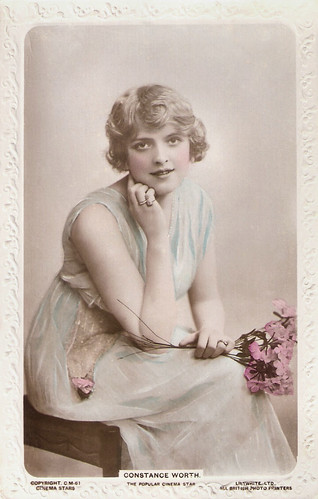
British postcard in the Cinema Stars series by Lilywhite, no. CM-61.
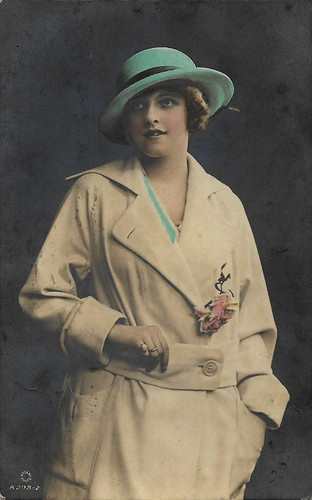
British postcard by Rotary Photo, no. A 298/2, hand-coloured.
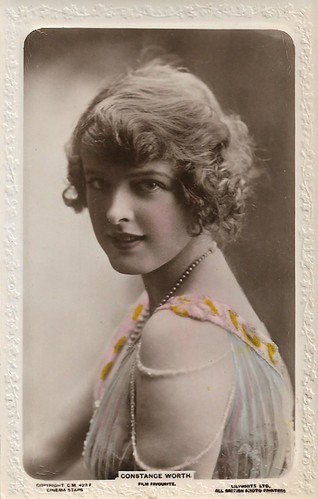
British postcard in the Cinema Stars series by Lilywhite Ltd. London, no. CM-423 F. Caption: Film Favourite.
An artist framing a parson for poisoning his wife
Constance Worth was born in 1892 in Rawdon, West Yorkshire, England as Constance Emsley Wadsworth.
Worth debuted in the British Lion film A Non-conformist Parson (A.V. Bramble, 1919), about an artist framing a parson for poisoning his wife. She immediately had the female lead in the film.
Worth remained with British Lion for The Starting Point (Edwin J. Collins, 1919) and Wisp o' the Woods (Cecil M. Hepworth, Louis Willoughby, 1919).
In 1920 she worked for the Anglo-Hollandia company, where she had the female lead in the Dutch-British coproduction Fate's Plaything/Wat eeuwig blijft (Maurits Binger, B.E. Doxat-Pratt, 1920), distributed by Butcher.
The plot is about a woman (Worth) who on the eve of her engagement runs away with a dancer ( Adelqui Migliar ). When pregnant, she runs away from him when he gets brutal, and finds refuge with a hunchback bachelor (Hector Abbas). Years after, a doctor saves the life of her child and he proves to be her ex-fiancée (Bruce Gordon). They reunite.
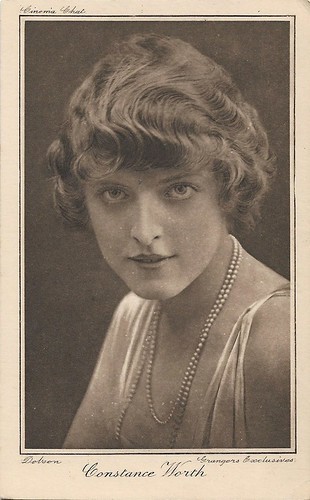
British postcard in the Cinema Chat series. Photo: Dolson / Grangers Exclusives.
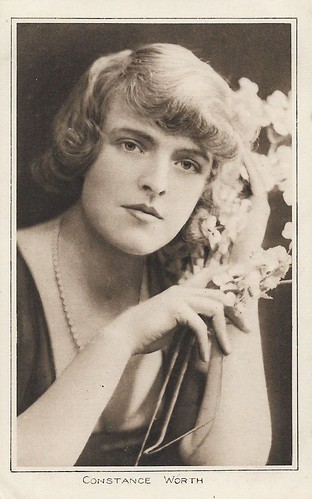
British postcard by "Pictures" Portrait Gallery, London, no. 52. Photo: Claude Harris Ltd.
A lieutenant who plants a baby on a retired captain
Constance Worth then did a range of films with James Knight and Marjorie Villis for the Harma company, The Education of Nicky (Arthur Rooke, 1921), Love in the Welsh Hills (Bernard Dudley, 1921), and No. 7 Brick Row (Fred W. Durrant, 1922), distributed by Walturdaw.
Rooke directed her again in A Bachelor's Baby (Arthur Rooke, 1922), distributed by the company Granger (so this card may refer to that film). The story of the latter is about a lieutenant (Malcolm Tod) who plants a baby on a retired captain (Tom Reynolds) to promote his romance with a neighbour's niece (Worth).
Worth's last part was in the Franco-Austrian film La maison dans la forêt/Das Haus im Walde/The House in the Forest (Jean Legrand, 1922), also with Jean Angelo and Gerald Ames .
Constance Worth died age 80 in Palm Beach, Florida, in 1973. She was married to Alfred Herbert Taylor who worked under the stage name Dan Rolyat (1915-1924) and to Frano Petrinovic from 1927 till his death in 1951. They had one child.
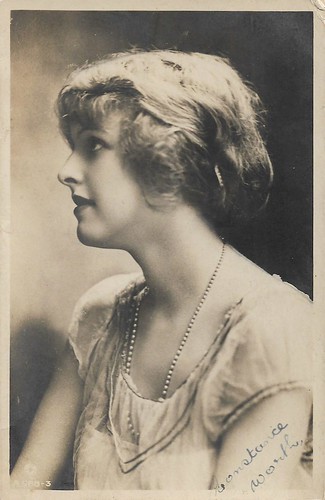
British postcard by Rotary Photo. Sent by mail in 1919.
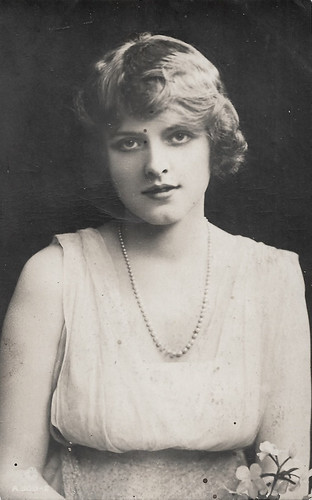
British postcard by Rotary Photo. On the back: "This is a Real Photograph of a British Beauty: Constance Worth".
Sources: Wikipedia and .

British postcard in the Cinema Stars series by Lilywhite, no. CM-61.

British postcard by Rotary Photo, no. A 298/2, hand-coloured.

British postcard in the Cinema Stars series by Lilywhite Ltd. London, no. CM-423 F. Caption: Film Favourite.
An artist framing a parson for poisoning his wife
Constance Worth was born in 1892 in Rawdon, West Yorkshire, England as Constance Emsley Wadsworth.
Worth debuted in the British Lion film A Non-conformist Parson (A.V. Bramble, 1919), about an artist framing a parson for poisoning his wife. She immediately had the female lead in the film.
Worth remained with British Lion for The Starting Point (Edwin J. Collins, 1919) and Wisp o' the Woods (Cecil M. Hepworth, Louis Willoughby, 1919).
In 1920 she worked for the Anglo-Hollandia company, where she had the female lead in the Dutch-British coproduction Fate's Plaything/Wat eeuwig blijft (Maurits Binger, B.E. Doxat-Pratt, 1920), distributed by Butcher.
The plot is about a woman (Worth) who on the eve of her engagement runs away with a dancer ( Adelqui Migliar ). When pregnant, she runs away from him when he gets brutal, and finds refuge with a hunchback bachelor (Hector Abbas). Years after, a doctor saves the life of her child and he proves to be her ex-fiancée (Bruce Gordon). They reunite.

British postcard in the Cinema Chat series. Photo: Dolson / Grangers Exclusives.

British postcard by "Pictures" Portrait Gallery, London, no. 52. Photo: Claude Harris Ltd.
A lieutenant who plants a baby on a retired captain
Constance Worth then did a range of films with James Knight and Marjorie Villis for the Harma company, The Education of Nicky (Arthur Rooke, 1921), Love in the Welsh Hills (Bernard Dudley, 1921), and No. 7 Brick Row (Fred W. Durrant, 1922), distributed by Walturdaw.
Rooke directed her again in A Bachelor's Baby (Arthur Rooke, 1922), distributed by the company Granger (so this card may refer to that film). The story of the latter is about a lieutenant (Malcolm Tod) who plants a baby on a retired captain (Tom Reynolds) to promote his romance with a neighbour's niece (Worth).
Worth's last part was in the Franco-Austrian film La maison dans la forêt/Das Haus im Walde/The House in the Forest (Jean Legrand, 1922), also with Jean Angelo and Gerald Ames .
Constance Worth died age 80 in Palm Beach, Florida, in 1973. She was married to Alfred Herbert Taylor who worked under the stage name Dan Rolyat (1915-1924) and to Frano Petrinovic from 1927 till his death in 1951. They had one child.

British postcard by Rotary Photo. Sent by mail in 1919.

British postcard by Rotary Photo. On the back: "This is a Real Photograph of a British Beauty: Constance Worth".
Sources: Wikipedia and .
Published on August 22, 2021 22:00
August 21, 2021
Francesca Bertini in La signora delle camelie (1915)
In the mid-1010s, Chocolate Pi in Barcelona released a series of 6 colourful collector cards of the Italian film La signora delle camelie/The Lady of the Camellias (Gustavo Serena, 1915). The drama was based on the popular novel and stage play 'La Dame aux Camélias' by Alexandre Dumas fils and this time the courtesan Marguerite Gautier was played by a famous diva of the Italian silent cinema, Francesca Bertini.
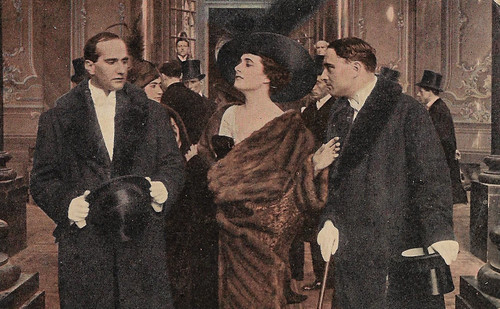
Spanish collector card by Chocolate Pi, Barcelona, no. 1 of series of 6 cards. Photo: Caesar Film. Francesca Bertini and Gustavo Serena in La signora delle camelie (Gustavo Serena, 1915). The man on the right is Carlo Benetti .
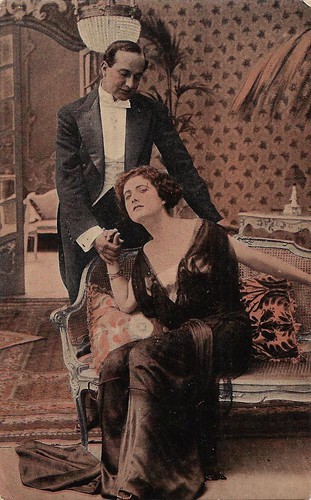
Spanish collector card by Chocolate Pi, Barcelona, no. 2 of series of 6 cards. Photo: Caesar Film. Francesca Bertini and Gustavo Serena in La signora delle camelie (Gustavo Serena, 1915).

Spanish collector card by Chocolate Pi, Barcelona, no. 3 of series of 6 cards. Photo: Caesar Film. Francesca Bertini and Gustavo Serena in La signora delle camelie (Gustavo Serena, 1915).
After a life with many men, she chooses Armand
La signora delle camelie/The Lady of the Camellias (Gustavo Serena, 1915) chronicles the well-known tragic love story of courtesan Marguerite Gautier ( Francesca Bertini ) and the provincial bourgeois Armand Duval ( Gustavo Serena ). After a life with many men, she chooses Armand. Yet, unknowing to Armand, Marguerite accepts Armand's father's (Antonio Cruichi) plea to separate herself from Armand because of the family's reputation and she sells all of her belongings.
Armand is so upset about the separation that, before a shocked audience of many, he throws stacks of money onto her, shouting out that he has now fully paid his debts. Marguerite withdraws and succumbs to tuberculosis. Armand, whose repenting father has confessed Marguerite's sacrifice, is just in time to hold her in his arms before she dies.
Alexandre Dumas's play was scripted by Renzo Chiosso, the cinematography was by Bertini's fixed cameraman Alberto Carta, and the sets were by Alfredo Manzi. In addition to Bertini, Serena, and Cruichi, also other Caesar Film regulars such as Olga and Carlo Benetti , and Camillo De Riso were part of the cast. Olga played the role of Marguerite's friend Mme Duvernoy, the Flora of Verdi's opera.
Dumas's play was indeed turned into one of the most famous operas by Giuseppe Verdi, 'La Traviata', in which the main characters were called Violetta and Alfredo. Even if a fiasco at its premiere in 1853 in Venice, it has become a classic, and probably Verdi's most performed opera. Arias from 'La Traviata' have led a life of their own, and the scene on the sixth card perfectly expresses the aria 'Addio al passato' in the opera.
Bertini's film was a huge hit at the time, and all over Europe, the film was shown for months in a row. And this despite fierce competition within Italy from a parallel released version of La signora delle camelie starring Hesperia , and directed by Hesperia's husband and promotor Baldassarre Negroni. While camera-wise perhaps not very innovative, the performances by the leads and the settings and costumes are very remarkable.
M. Congedi at IMDb : "In 1915, 'La Bertini' and Serena were setting standards in cinema worldwide with their subtle and realistic acting. This acting brilliance was most notable in their collaboration on the silent masterpiece Assunta Spina filmed in the same year, arguably the finest film made that year, anywhere. Compared to other major titles of the same period, this film lacks some of the technical brilliance that was developing in cinema at the time (e.g. camera movement, facial close-ups), but the film makes up for this lack in other ways. The compositions are elegant, the way scenes are lit are well thought out (note the light and darkness on Bertini's face in certain scenes), the acting subtle (for its time), the crowd scenes are so well-handled."
In 1992 a restoration of the film was made, on basis of, alas, poor materials. Provided with a new score by Ennio Morricone, the film was shown to the Roman beau-monde at the Teatro Sistina in Rome, a fitting venue for such a bourgeois spectacle. Unfortunately for Bertini, she had already died in 1985. She deplored in the documentary L'ultima diva (Gianfranco Mingozzi, 1983) that so little of her oeuvre had survived. Luckily, more and more film prints of her film career have shown up all over the globe and have been preserved, such as Sangue bleu and Il processo Clemenceau. Several titles are still missing, while from two other successful films of hers, Tosca and Fedora, only fragments have resurfaced but no complete prints.
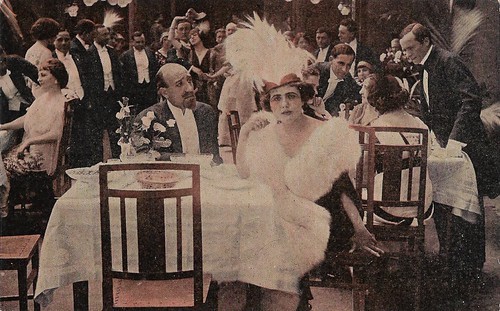
Spanish collector card by Chocolate Pi, Barcelona, no. 4 of series of 6 cards. Photo: Caesar Film. Francesca Bertini and probably Antonio Cruichi in La signora delle camelie (Gustavo Serena, 1915). If this is the scene with Armand's father, then the Verdi operatic equivalent would be the aria of Germont: 'Di Provenza il mar, il suol'.
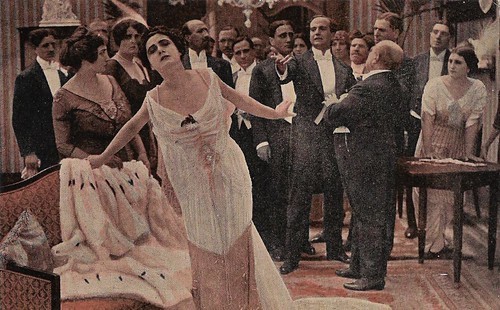
Spanish collector card by Chocolate Pi, Barcelona, no. 5 of series of 6 cards. Photo: Caesar Film. Francesca Bertini and Gustavo Serena in La signora delle camelie (Gustavo Serena, 1915). The little rotund man on the right is Camillo De Riso . The man just left of Serena, looking at him, is Carlo Benetti . The woman whose head is partly covered by Bertini is Olga Benetti .
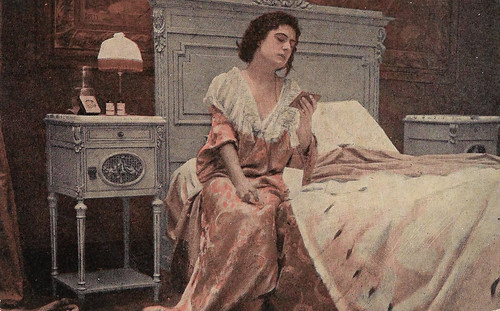
Spanish collector card by Chocolate Pi, Barcelona, no. 6 of series of 6 cards. Photo: Caesar Film. Francesca Bertini in La signora delle camelie (Gustavo Serena, 1915).
Sources: Wikipedia and IMDb.

Spanish collector card by Chocolate Pi, Barcelona, no. 1 of series of 6 cards. Photo: Caesar Film. Francesca Bertini and Gustavo Serena in La signora delle camelie (Gustavo Serena, 1915). The man on the right is Carlo Benetti .

Spanish collector card by Chocolate Pi, Barcelona, no. 2 of series of 6 cards. Photo: Caesar Film. Francesca Bertini and Gustavo Serena in La signora delle camelie (Gustavo Serena, 1915).

Spanish collector card by Chocolate Pi, Barcelona, no. 3 of series of 6 cards. Photo: Caesar Film. Francesca Bertini and Gustavo Serena in La signora delle camelie (Gustavo Serena, 1915).
After a life with many men, she chooses Armand
La signora delle camelie/The Lady of the Camellias (Gustavo Serena, 1915) chronicles the well-known tragic love story of courtesan Marguerite Gautier ( Francesca Bertini ) and the provincial bourgeois Armand Duval ( Gustavo Serena ). After a life with many men, she chooses Armand. Yet, unknowing to Armand, Marguerite accepts Armand's father's (Antonio Cruichi) plea to separate herself from Armand because of the family's reputation and she sells all of her belongings.
Armand is so upset about the separation that, before a shocked audience of many, he throws stacks of money onto her, shouting out that he has now fully paid his debts. Marguerite withdraws and succumbs to tuberculosis. Armand, whose repenting father has confessed Marguerite's sacrifice, is just in time to hold her in his arms before she dies.
Alexandre Dumas's play was scripted by Renzo Chiosso, the cinematography was by Bertini's fixed cameraman Alberto Carta, and the sets were by Alfredo Manzi. In addition to Bertini, Serena, and Cruichi, also other Caesar Film regulars such as Olga and Carlo Benetti , and Camillo De Riso were part of the cast. Olga played the role of Marguerite's friend Mme Duvernoy, the Flora of Verdi's opera.
Dumas's play was indeed turned into one of the most famous operas by Giuseppe Verdi, 'La Traviata', in which the main characters were called Violetta and Alfredo. Even if a fiasco at its premiere in 1853 in Venice, it has become a classic, and probably Verdi's most performed opera. Arias from 'La Traviata' have led a life of their own, and the scene on the sixth card perfectly expresses the aria 'Addio al passato' in the opera.
Bertini's film was a huge hit at the time, and all over Europe, the film was shown for months in a row. And this despite fierce competition within Italy from a parallel released version of La signora delle camelie starring Hesperia , and directed by Hesperia's husband and promotor Baldassarre Negroni. While camera-wise perhaps not very innovative, the performances by the leads and the settings and costumes are very remarkable.
M. Congedi at IMDb : "In 1915, 'La Bertini' and Serena were setting standards in cinema worldwide with their subtle and realistic acting. This acting brilliance was most notable in their collaboration on the silent masterpiece Assunta Spina filmed in the same year, arguably the finest film made that year, anywhere. Compared to other major titles of the same period, this film lacks some of the technical brilliance that was developing in cinema at the time (e.g. camera movement, facial close-ups), but the film makes up for this lack in other ways. The compositions are elegant, the way scenes are lit are well thought out (note the light and darkness on Bertini's face in certain scenes), the acting subtle (for its time), the crowd scenes are so well-handled."
In 1992 a restoration of the film was made, on basis of, alas, poor materials. Provided with a new score by Ennio Morricone, the film was shown to the Roman beau-monde at the Teatro Sistina in Rome, a fitting venue for such a bourgeois spectacle. Unfortunately for Bertini, she had already died in 1985. She deplored in the documentary L'ultima diva (Gianfranco Mingozzi, 1983) that so little of her oeuvre had survived. Luckily, more and more film prints of her film career have shown up all over the globe and have been preserved, such as Sangue bleu and Il processo Clemenceau. Several titles are still missing, while from two other successful films of hers, Tosca and Fedora, only fragments have resurfaced but no complete prints.

Spanish collector card by Chocolate Pi, Barcelona, no. 4 of series of 6 cards. Photo: Caesar Film. Francesca Bertini and probably Antonio Cruichi in La signora delle camelie (Gustavo Serena, 1915). If this is the scene with Armand's father, then the Verdi operatic equivalent would be the aria of Germont: 'Di Provenza il mar, il suol'.

Spanish collector card by Chocolate Pi, Barcelona, no. 5 of series of 6 cards. Photo: Caesar Film. Francesca Bertini and Gustavo Serena in La signora delle camelie (Gustavo Serena, 1915). The little rotund man on the right is Camillo De Riso . The man just left of Serena, looking at him, is Carlo Benetti . The woman whose head is partly covered by Bertini is Olga Benetti .

Spanish collector card by Chocolate Pi, Barcelona, no. 6 of series of 6 cards. Photo: Caesar Film. Francesca Bertini in La signora delle camelie (Gustavo Serena, 1915).
Sources: Wikipedia and IMDb.
Published on August 21, 2021 22:00
August 20, 2021
17 New treasures
Today a post with all kinds of postcards I've found and acquired in the last months. Just for the fun of it.
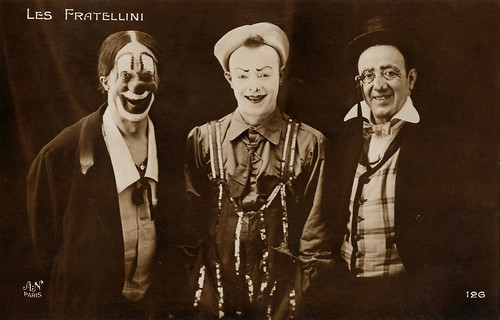
French postcard by A.N., Paris, no. 126. From left to right, Albert, François and Paolo (Paul) Fratellini.
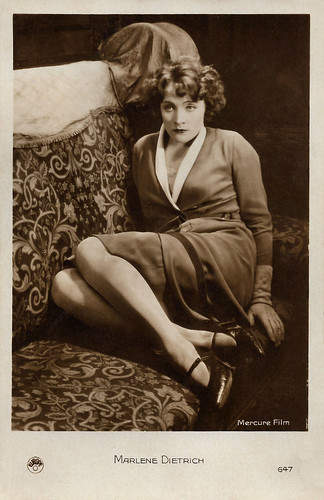
French postcard by Europe, no. 647. Photo: Mercure Film. Marlene Dietrich in Die Frau, nach der man sich sehnt/The Woman One Longs For (Kurt Bernhardt, 1929).
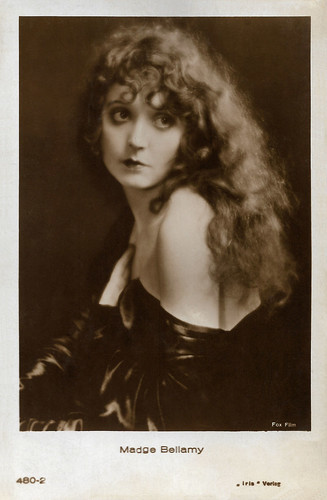
Austrian postcard by Iris-Verlag, no. 480-2. Photo: Fox Film. Madge Bellamy .
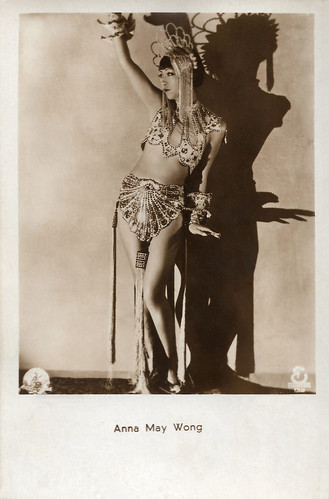
Austrian postcard by Iris-Verlag, no. 5853. Photo: British International Pictures (BIP). Anna May Wong in Piccadilly (Ewald André Dupont, 1929).
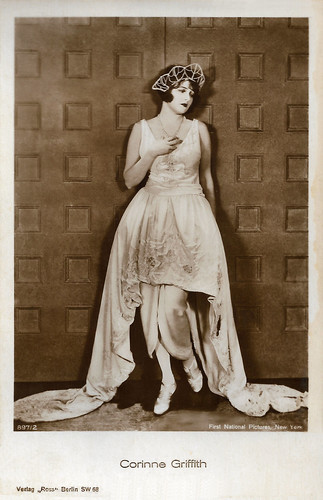
German postcard by Ross Verlag, no. 897/2, 1925-1926. Photo: First National Pictures, New York. Corinne Griffith .
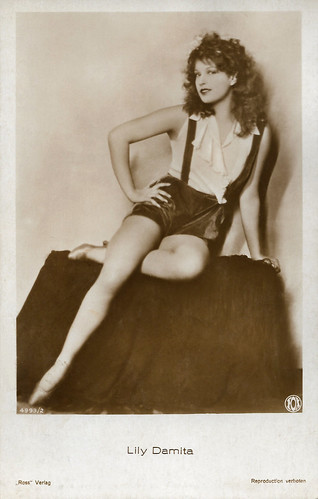
German postcard by Ross Verlag, no. 4993/2, 1929-1930. Photo: Fox. Lily Damita .
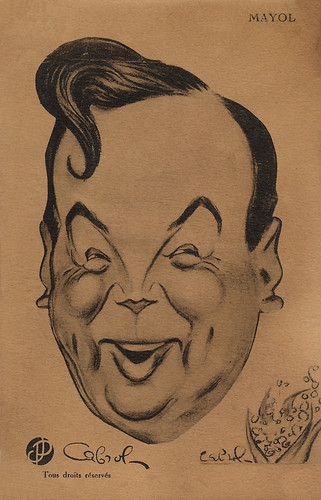
French postcard by Publications J.P., Paris. Caricature by Raoul Cabrol. Félix Mayol .

Big German card by Ross Verlag. Photo: Paramount. Buster Crabbe in King of the Jungle (H. Bruce Humberstone, Max Marcin, 1933).
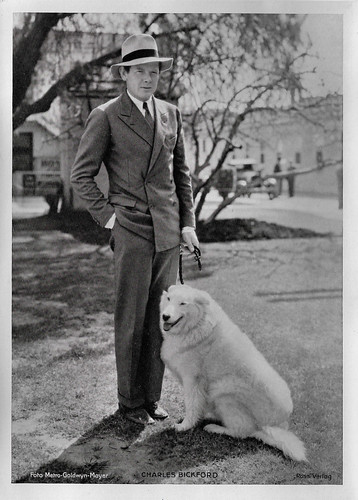
Big German collectors card by Ross Verlag. Photo: Metro-Goldwyn-Mayer. Charles Bickford .
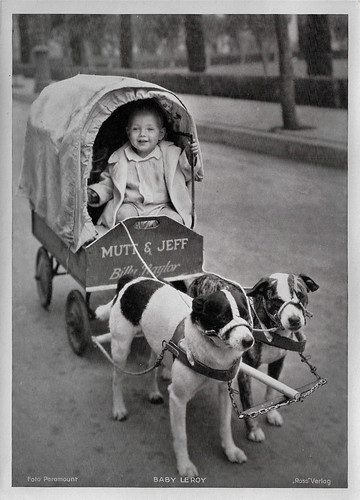
Big German collectors card by Ross Verlag. Photo: Paramount. Baby LeRoy embarks on a tour of the Paramount studios in a cart pulled by two dogs, Mutt and Jeff, Hollywood, circa 1934.
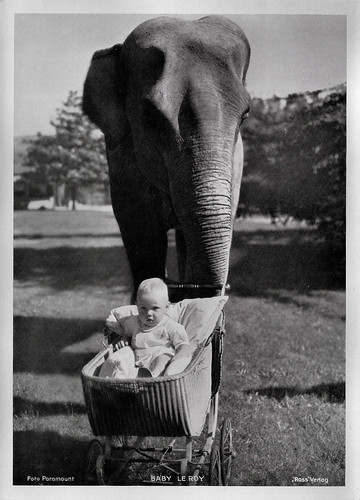
Big German collectors card by Ross Verlag. Photo: Paramount. Baby LeRoy.
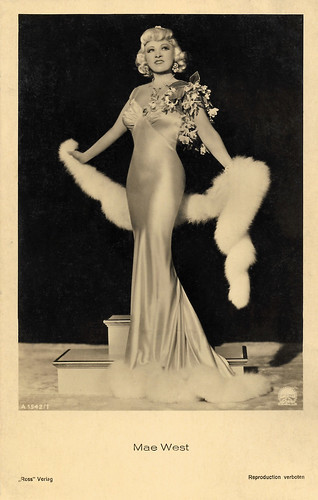
German postcard by Ross Verlag, no. A 1542/1, 1937-1938. Photo: Paramount Pictures. Mae West .
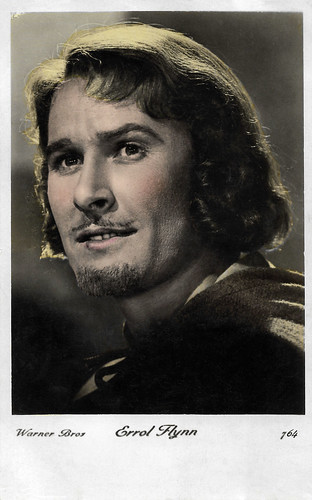
French postcard, no. 764. Photo: Warner Bros. Errol Flynn in The Adventures of Robin Hood (Michael Curtiz, William Keighley, 1938).
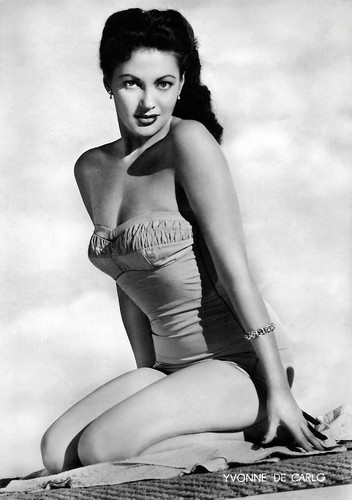
Italian postcard, no. 358. Yvonne De Carlo .
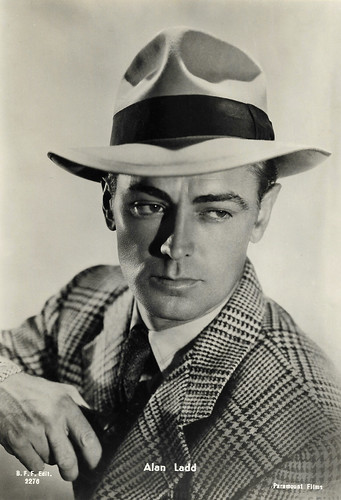
Italian postcard by B.F.F. Edit., no. 2276. Photo: Paramount Films. Alan Ladd .
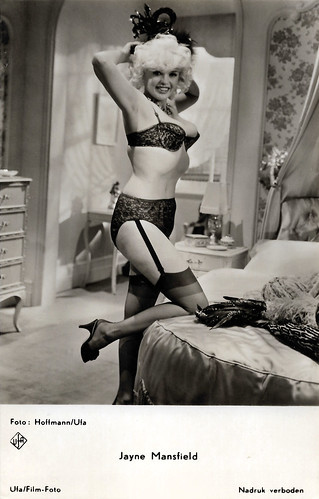
Dutch postcard by Gebr. Spanjersberg N.V., Rotterdam, no. 1301. Photo: Hoffmann / Ufa. Jayne Mansfield .
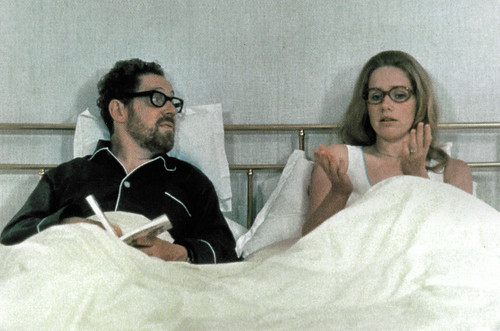
French postcard for the French DVD release by Dark Star / Carlotta. Photo: AV Svenska Film Industr. Erland Josephson and Liv Ullmann in Scener ur ett äktenskap/Scenes from a Marriage (Ingmar Bergman, 1973).

French postcard by A.N., Paris, no. 126. From left to right, Albert, François and Paolo (Paul) Fratellini.

French postcard by Europe, no. 647. Photo: Mercure Film. Marlene Dietrich in Die Frau, nach der man sich sehnt/The Woman One Longs For (Kurt Bernhardt, 1929).

Austrian postcard by Iris-Verlag, no. 480-2. Photo: Fox Film. Madge Bellamy .

Austrian postcard by Iris-Verlag, no. 5853. Photo: British International Pictures (BIP). Anna May Wong in Piccadilly (Ewald André Dupont, 1929).

German postcard by Ross Verlag, no. 897/2, 1925-1926. Photo: First National Pictures, New York. Corinne Griffith .

German postcard by Ross Verlag, no. 4993/2, 1929-1930. Photo: Fox. Lily Damita .

French postcard by Publications J.P., Paris. Caricature by Raoul Cabrol. Félix Mayol .

Big German card by Ross Verlag. Photo: Paramount. Buster Crabbe in King of the Jungle (H. Bruce Humberstone, Max Marcin, 1933).

Big German collectors card by Ross Verlag. Photo: Metro-Goldwyn-Mayer. Charles Bickford .

Big German collectors card by Ross Verlag. Photo: Paramount. Baby LeRoy embarks on a tour of the Paramount studios in a cart pulled by two dogs, Mutt and Jeff, Hollywood, circa 1934.

Big German collectors card by Ross Verlag. Photo: Paramount. Baby LeRoy.

German postcard by Ross Verlag, no. A 1542/1, 1937-1938. Photo: Paramount Pictures. Mae West .

French postcard, no. 764. Photo: Warner Bros. Errol Flynn in The Adventures of Robin Hood (Michael Curtiz, William Keighley, 1938).

Italian postcard, no. 358. Yvonne De Carlo .

Italian postcard by B.F.F. Edit., no. 2276. Photo: Paramount Films. Alan Ladd .

Dutch postcard by Gebr. Spanjersberg N.V., Rotterdam, no. 1301. Photo: Hoffmann / Ufa. Jayne Mansfield .

French postcard for the French DVD release by Dark Star / Carlotta. Photo: AV Svenska Film Industr. Erland Josephson and Liv Ullmann in Scener ur ett äktenskap/Scenes from a Marriage (Ingmar Bergman, 1973).
Published on August 20, 2021 22:00
August 19, 2021
Robert Wagner
American actor Robert Wagner (1930) started his career as a handsome hunk in Hollywood films like A Kiss Before Dying (Gerd Oswald, 1956). In the following decades, he appeared in such box office hits as The Pink Panther (Blake Edwards, 1963), Harper (Jack Smight, 1966) starring Paul Newman, and the disaster film The Towering Inferno (John Guillermin, 1974). He is best known for starring in the television shows It Takes a Thief (1968–1970) with Fred Astaire, Switch (1975–1978) opposite Eddie Albert, and Hart to Hart (1979–1984), co-starring Stefanie Powers.

Italian postcard by Rotalfoto, Milano, no. 31. Photo: Robert Wagner in White Feather (Robert D. Webb, 1955).

West-German postcard by Rüdel-Verlag, Hamburg-Bergedorf, no. 1257. Photo: 20th Century-Fox. Robert Wagner in Prince Valiant (Henry Hathaway, 1954).
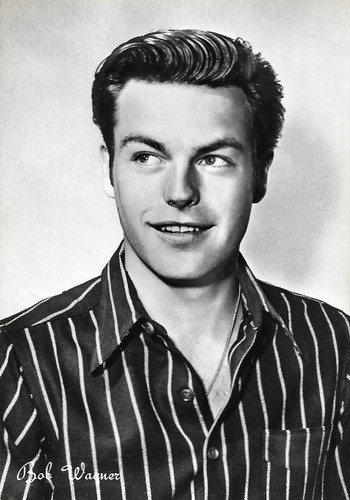
Italian postcard by Rotalfoto, Milano, no. 401.
Unable to make the transition to top-level star
Robert John 'R.J.' Wagner was born 1930 in Detroit. He is the son of Hazel Alvera (née Boe), a telephone operator, and Robert John Wagner Sr., a traveling salesman who worked for the Ford Motor Company.
His family moved to Los Angeles when he was seven. Wagner attended and graduated from Santa Monica High School in Santa Monica, and attended military academies and Harvard. Always wanting to be an actor, he held a variety of jobs while pursuing his goal.
After making his uncredited screen debut in The Happy Years (William A. Wellman, 1950), he was signed by agent Henry Willson. He was put under contract with 20th Century-Fox, which carefully built him up toward stardom.
He played romantic leads with ease, but it was not until he essayed the two-scene role of a shell-shocked war veteran in With a Song in My Heart (Walter Lang, 1952) starring Susan Hayward, that studio executives recognised his potential as a dramatic actor.
He supported James Cagney and Dan Dailey in John Ford's version of What Price Glory (1952) and supported Clifton Webb and Barbara Stanwyck in Titanic (Jean Negulesco, 1953).
Fox gave Wagner his first starring role in Beneath the 12-Mile Reef (Robert D. Webb, 1953) with Terry Moore and Gilbert Roland. The screenplay by A.I. Bezzerides was inspired by 'Romeo and Juliet' by William Shakespeare. Reviews were poor but the film was only the third ever to be shot in CinemaScope and was a big hit.
Wagner went on to play the title roles in Prince Valiant (Henry Hathaway, 1954) opposite James Mason and Janet Leigh, and The True Story of Jesse James (Nicholas Ray, 1957), with Jeffrey Hunter. He portrayed a ruthless college student, who resorts to murder in an attempt to marry an heiress (Joanne Woodward) in A Kiss Before Dying (Gerd Oswald, 1956). The latter two films were box office disappointments and it seemed Wagner was unable to make the transition to top-level star.
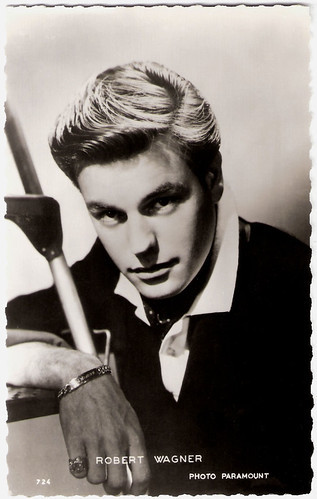
French postcard by Editions P.I., Paris, offered by Les Carbones Korès Carboplane, no. 24 H. Photo: Paramount, 1956.
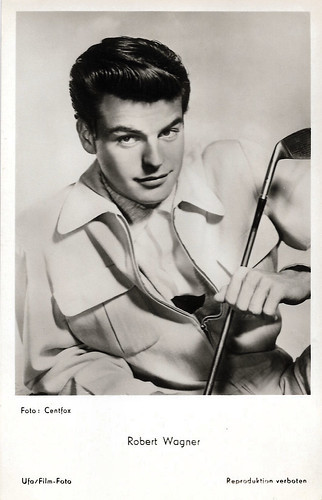
German postcard by Ufa/Film-Foto, Berlin-Tempelhof, no. FK 3512. Photo: Centfox.
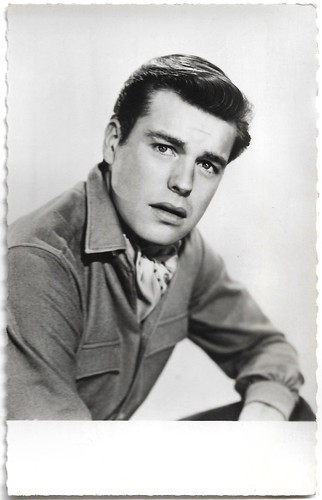
French postcard by Editions P.I., Paris, no. 998. Photo: Robert Wagner in The Mountain (Edward Dmytryk, 1956).
A respectable transition to television
In Europe, Robert Wagner had a small role in the epic war film The Longest Day (Ken Annakin, a.o., 1962), produced by Daryl Zanuck for Fox. He had a larger part in The Condemned of Altona (1962), a commercial and critical disappointment despite being directed by Vittorio de Sica and co-starring Sophia Loren .
In the mid-1960s, Robert Wagner's film career skidded to a stop after the massive hit The Pink Panther (Blake Edwards, 1963) with David Niven , Peter Sellers , and Claudia Cardinale . Blake Edwards wanted Wagner for the lead in The Great Race (1965), but Jack L. Warner overruled him.
Wagner found a good supporting role in the modern-day private investigator hit, Harper (Jack Smight, 1966), starring Paul Newman. He signed with Universal Pictures in 1966, starring opposite future wife Jill St. John in the films How I Spent My Summer Vacation/Deadly Roulette (William Hale, 1967), and Banning (Ron Winston, 1967).
He returned to Italy to make a caper film with Raquel Welch for MGM, The Biggest Bundle of Them All (Ken Annakin, 1968), but it was not a success.
Wagner made a respectable transition to television as the star of the lighthearted espionage series It Takes a Thief (1968) with Fred Astaire. He also starred in the police series Switch (1975) with Eddie Albert and Sharon Gless.
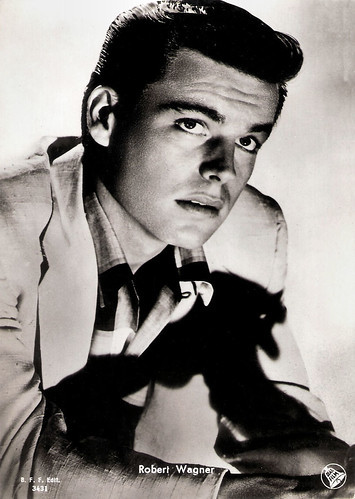
Italian postcard by B.F.F. Edit., no. 3431. Photo: Dear Film. Robert Wagner in A Kiss Before Dying (Gerd Oswald, 1956).
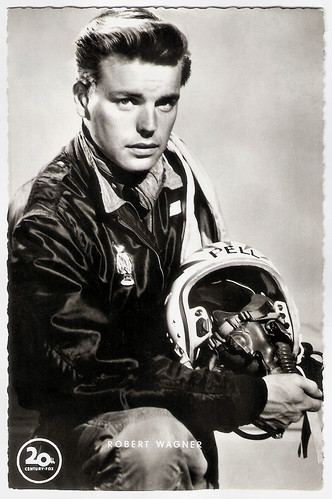
German postcard by Kunst und Bild, Charlottenbrug. Photo: 20th Century Fox. Robert Wagner in The Hunters (Robert D. Webb, 1958).
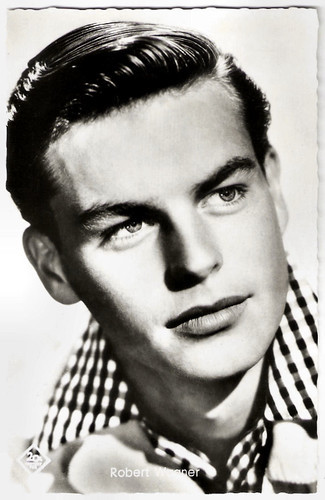
West-German postcard by Kolibri-Verlag, G.m.b.H., Minden/Westf., no. 1582. Photo: 20th Century Fox.
One of Hollywood's nicest citizens
Robert Wagner's greatest success was opposite Stefanie Powers on the internationally popular TV series Hart to Hart (1979), which ran from 1979 through 1984 and has since been sporadically revived in TV-movie form. Another series, Lime Street (1985-1986), was quickly canceled due to the tragic death of Wagner's young co-star, Samantha Smith.
Considered one of Hollywood's nicest citizens, Robert Wagner has continued to successfully pursue a leading man career; he has also launched a latter-day stage career, touring with Stefanie Powers in the readers' theater presentation 'Love Letters'. He also had a recurring role as Teddy Leopold on the TV sitcom Two and a Half Men (2007-2008) and had a recurring role as Anthony DiNozzo Sr. on the police procedural NCIS (2010-2014).
In the cinema, Wagner played Number Two, a henchman to Dr. Evil opposite Mike Myers in Austin Powers: International Man of Mystery (Jay Roach, 1997) and its sequels, Austin Powers: The Spy Who Shagged Me (Jay Roach, 1999) and Austin Powers in Goldmember (Jay Roach, 2002).
In 2008, Wagner published his autobiography 'Pieces of My Heart: A Life', written together with author Scott Eyman. Robert Wagner says in his autobiography that he had a four-year relationship with Barbara Stanwyck who was more than twenty years older than he was. He says she was his first great love and that she gave him more than any woman in his life.
Robert Wagner married four times. He married Natalie Wood twice (1957-1962) and (1972-1981 - her death). In between, he was married to Marion Marshall (1963-1971). Since 1990, he is married to actress Jill St. John. He has known her since 1959, and they've been a couple since 1982, eight years before their wedding.
Robert Wagner is the father of Katie Wagner (1964) with Marion Marshall and Courtney Wagner (1974) with Natalie Wood. Though the double surname suggests otherwise, he never legally adopted his ex-stepdaughter Natasha Gregson Wagner. In 2006, he became a grandfather when his daughter Katie Wagner gave birth to her son, Riley John.
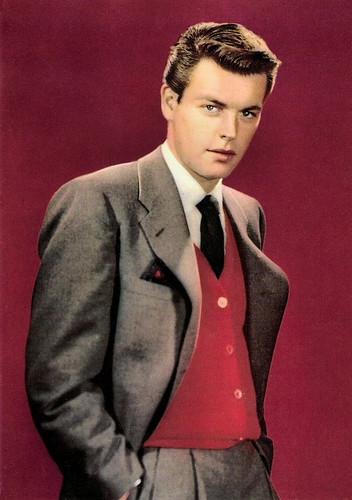
Italian postcard by Rotalfoto, Milano, no. 26.
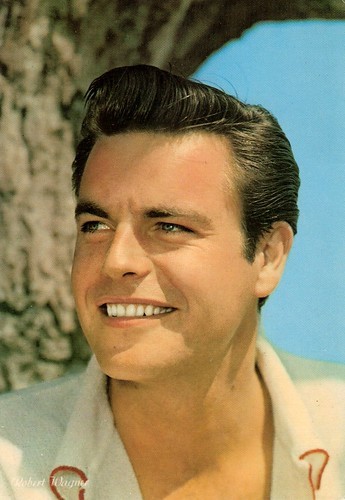
Italian postcard in the series Artisti di Sempre by Ed. ris. Rotalfoto S.p.A., Milano, no. 287.
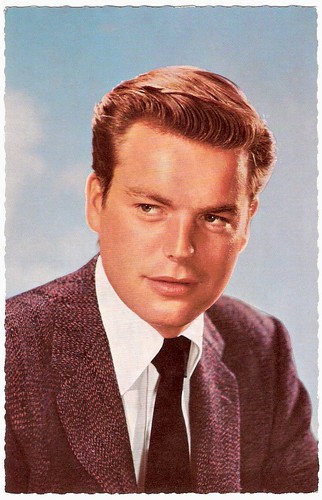
German postcard by Kunst und Bild, Berlin-Charlottenburg, no. CD4.
Sources: Wikipedia and .

Italian postcard by Rotalfoto, Milano, no. 31. Photo: Robert Wagner in White Feather (Robert D. Webb, 1955).

West-German postcard by Rüdel-Verlag, Hamburg-Bergedorf, no. 1257. Photo: 20th Century-Fox. Robert Wagner in Prince Valiant (Henry Hathaway, 1954).

Italian postcard by Rotalfoto, Milano, no. 401.
Unable to make the transition to top-level star
Robert John 'R.J.' Wagner was born 1930 in Detroit. He is the son of Hazel Alvera (née Boe), a telephone operator, and Robert John Wagner Sr., a traveling salesman who worked for the Ford Motor Company.
His family moved to Los Angeles when he was seven. Wagner attended and graduated from Santa Monica High School in Santa Monica, and attended military academies and Harvard. Always wanting to be an actor, he held a variety of jobs while pursuing his goal.
After making his uncredited screen debut in The Happy Years (William A. Wellman, 1950), he was signed by agent Henry Willson. He was put under contract with 20th Century-Fox, which carefully built him up toward stardom.
He played romantic leads with ease, but it was not until he essayed the two-scene role of a shell-shocked war veteran in With a Song in My Heart (Walter Lang, 1952) starring Susan Hayward, that studio executives recognised his potential as a dramatic actor.
He supported James Cagney and Dan Dailey in John Ford's version of What Price Glory (1952) and supported Clifton Webb and Barbara Stanwyck in Titanic (Jean Negulesco, 1953).
Fox gave Wagner his first starring role in Beneath the 12-Mile Reef (Robert D. Webb, 1953) with Terry Moore and Gilbert Roland. The screenplay by A.I. Bezzerides was inspired by 'Romeo and Juliet' by William Shakespeare. Reviews were poor but the film was only the third ever to be shot in CinemaScope and was a big hit.
Wagner went on to play the title roles in Prince Valiant (Henry Hathaway, 1954) opposite James Mason and Janet Leigh, and The True Story of Jesse James (Nicholas Ray, 1957), with Jeffrey Hunter. He portrayed a ruthless college student, who resorts to murder in an attempt to marry an heiress (Joanne Woodward) in A Kiss Before Dying (Gerd Oswald, 1956). The latter two films were box office disappointments and it seemed Wagner was unable to make the transition to top-level star.

French postcard by Editions P.I., Paris, offered by Les Carbones Korès Carboplane, no. 24 H. Photo: Paramount, 1956.

German postcard by Ufa/Film-Foto, Berlin-Tempelhof, no. FK 3512. Photo: Centfox.

French postcard by Editions P.I., Paris, no. 998. Photo: Robert Wagner in The Mountain (Edward Dmytryk, 1956).
A respectable transition to television
In Europe, Robert Wagner had a small role in the epic war film The Longest Day (Ken Annakin, a.o., 1962), produced by Daryl Zanuck for Fox. He had a larger part in The Condemned of Altona (1962), a commercial and critical disappointment despite being directed by Vittorio de Sica and co-starring Sophia Loren .
In the mid-1960s, Robert Wagner's film career skidded to a stop after the massive hit The Pink Panther (Blake Edwards, 1963) with David Niven , Peter Sellers , and Claudia Cardinale . Blake Edwards wanted Wagner for the lead in The Great Race (1965), but Jack L. Warner overruled him.
Wagner found a good supporting role in the modern-day private investigator hit, Harper (Jack Smight, 1966), starring Paul Newman. He signed with Universal Pictures in 1966, starring opposite future wife Jill St. John in the films How I Spent My Summer Vacation/Deadly Roulette (William Hale, 1967), and Banning (Ron Winston, 1967).
He returned to Italy to make a caper film with Raquel Welch for MGM, The Biggest Bundle of Them All (Ken Annakin, 1968), but it was not a success.
Wagner made a respectable transition to television as the star of the lighthearted espionage series It Takes a Thief (1968) with Fred Astaire. He also starred in the police series Switch (1975) with Eddie Albert and Sharon Gless.

Italian postcard by B.F.F. Edit., no. 3431. Photo: Dear Film. Robert Wagner in A Kiss Before Dying (Gerd Oswald, 1956).

German postcard by Kunst und Bild, Charlottenbrug. Photo: 20th Century Fox. Robert Wagner in The Hunters (Robert D. Webb, 1958).

West-German postcard by Kolibri-Verlag, G.m.b.H., Minden/Westf., no. 1582. Photo: 20th Century Fox.
One of Hollywood's nicest citizens
Robert Wagner's greatest success was opposite Stefanie Powers on the internationally popular TV series Hart to Hart (1979), which ran from 1979 through 1984 and has since been sporadically revived in TV-movie form. Another series, Lime Street (1985-1986), was quickly canceled due to the tragic death of Wagner's young co-star, Samantha Smith.
Considered one of Hollywood's nicest citizens, Robert Wagner has continued to successfully pursue a leading man career; he has also launched a latter-day stage career, touring with Stefanie Powers in the readers' theater presentation 'Love Letters'. He also had a recurring role as Teddy Leopold on the TV sitcom Two and a Half Men (2007-2008) and had a recurring role as Anthony DiNozzo Sr. on the police procedural NCIS (2010-2014).
In the cinema, Wagner played Number Two, a henchman to Dr. Evil opposite Mike Myers in Austin Powers: International Man of Mystery (Jay Roach, 1997) and its sequels, Austin Powers: The Spy Who Shagged Me (Jay Roach, 1999) and Austin Powers in Goldmember (Jay Roach, 2002).
In 2008, Wagner published his autobiography 'Pieces of My Heart: A Life', written together with author Scott Eyman. Robert Wagner says in his autobiography that he had a four-year relationship with Barbara Stanwyck who was more than twenty years older than he was. He says she was his first great love and that she gave him more than any woman in his life.
Robert Wagner married four times. He married Natalie Wood twice (1957-1962) and (1972-1981 - her death). In between, he was married to Marion Marshall (1963-1971). Since 1990, he is married to actress Jill St. John. He has known her since 1959, and they've been a couple since 1982, eight years before their wedding.
Robert Wagner is the father of Katie Wagner (1964) with Marion Marshall and Courtney Wagner (1974) with Natalie Wood. Though the double surname suggests otherwise, he never legally adopted his ex-stepdaughter Natasha Gregson Wagner. In 2006, he became a grandfather when his daughter Katie Wagner gave birth to her son, Riley John.

Italian postcard by Rotalfoto, Milano, no. 26.

Italian postcard in the series Artisti di Sempre by Ed. ris. Rotalfoto S.p.A., Milano, no. 287.

German postcard by Kunst und Bild, Berlin-Charlottenburg, no. CD4.
Sources: Wikipedia and .
Published on August 19, 2021 22:00
August 18, 2021
Julius Falkenstein
Julius Falkenstein (1879-1933) was a bald, often monocle-wearing German character actor. He was known for such films as Zopf und Schwert - Eine tolle Prinzessin (1926), Der Meister von Nürnberg (1927) and Ich und die Kaiserin (1933). Falkenstein appeared in 184 films between 1914 and 1933.
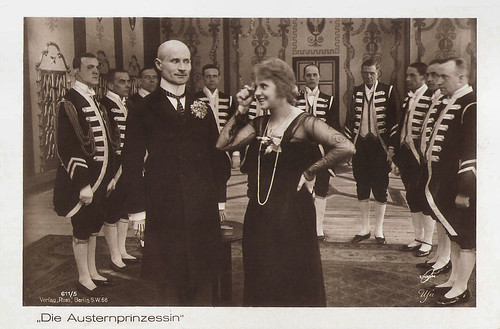
German postcard by Ross Verlag, Berlin, no. 611/5. Photo: Union / Ufa. Julius Falkenstein and Ossi Oswalda in Die Austernprinzessin/The Oyster Princess (Ernst Lubitsch, 1919).
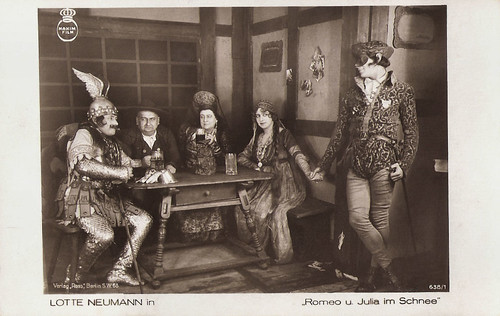
German postcard by Ross Verlag, no. 636/1. Ohoto: Maxim Film. Lotte Neumann in the comedy Romeo und Julia im Schnee/Romeo and Juliet in the Snow (Ernst Lubitsch, 1920). The man on the left dressed as antique hero could be Julius Falkenstein as Paris. The others are from left to right Jakob Tiedtke (Herr Capulethofer), Marga Köhler (his wife), Lotte Neumann (Julia) and Gustav von Wangenheim (Romeo Montekugerl).
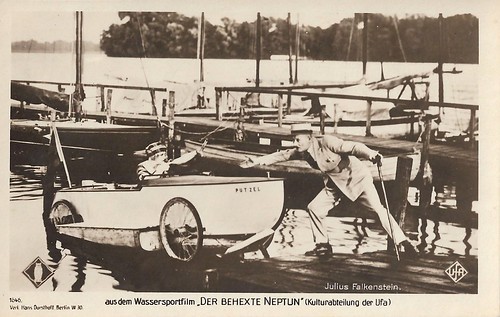
German postcard by Verlag Hans Dursthoff, Berlin, no. 1646. Photo: Ufa Kulturfilm. Julius Falkenstein in Der behexte Neptun (Willi Achsel, 1925).
One of the most popular film comedians of the German silent cinema
Julius Falkenstein was born in 1879 in Berlin, the capital of Germany.
Falkenstein probably received his first theatre engagement in Berlin in 1904/1905. From 1906, he was on stage at the Residenztheater in Berlin. In the following years, he played mostly on the Berlin theaters, interrupted only by engagements from 1908 to 1910 at the Lustspielhaus Düsseldorf, 1911 at the Vienna Volkstheater, and 1912 at the Theater an der Wien. Falkenstein, who was valued above all for his comedic qualities, often went on guest tours and acted himself several times as a game director.
From 1914, he was also prolific in silent films, essaying diverse eccentric character parts. He had his first film appearance in the detective film Die geheimnisvolle Villa/The Black Triangle (Joe May, 1914) the first in the series starring the fictional gentleman detective Stuart Webbs ( Ernst Reicher ), modeled on Sherlock Holmes.
During the silent era, he did his best work for the famous directors Friedrich Wilhelm Murnau and Ernst Lubitsch . For Murnau, he played in Schloß Vogelöd/The Haunted Castle (Friedrich Wilhelm Murnau, 1921), and Die Finanzen des Großherzogs/The Grand Duke's Finances (Friedrich Wilhelm Murnau, 1924) with Harry Liedtke and Mady Christians .
He appeared in such Lubitsch comedies as Der Rodelkavalier/The Toboggan Cavalier (Ernst Lubitsch, 1918) Die Austernprinzessin/The Oyster Princess (Ernst Lubitsch, 1919) starring Ossi Oswalda , and Romeo und Julia im Schnee/Romeo and Juliet in the Snow (Ernst Lubitsch, 1920) starring Lotte Neumann . Julius Falkenstein belonged to the most popular film comedians of the German silent cinema.
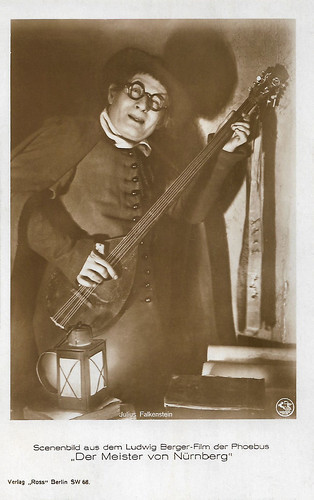
German postcard by Ross Verlag, Berlin. Photo: Phoebus Film Julius Falkenstein in the historical comedy Der Meister von Nürnberg (Ludwig Berger, 1927), based on Richard Wagner's opera 'Die Meistersinger von Nürnberg'.
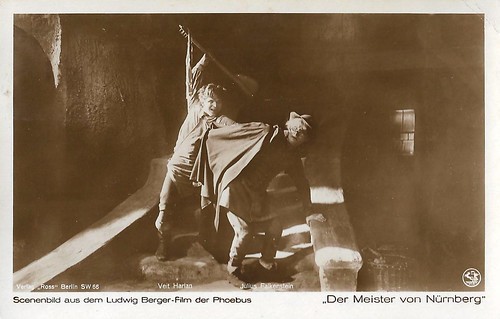
German postcard by Ross Verlag, Berlin. Photo: Phoebus Film. Veit Harlan and Julius Falkenstein in Der Meister von Nürnberg/The Master of Nuremberg (Ludwig Berger, 1927).
The audience has to laugh and cry at the same time
Julius Falkenstein played aristocrats, military, directors, secretaries, and accountants in a stream of films. In addition, he still found time for theater assignments, at the Komische Oper and in the Theater am Kurfürstendamm. He also wrote a comedy himself called 'Julie', which was staged with great success.
IMDb quotes Falkenstein: "It is my wish to play good tragic-comical roles under good directors - roles where the audience has to laugh and to cry at the same time".
The transition to the sound film didn't cause him any trouble. In the 1930s he even made more films than he did in the 1920s. In the last four years of his life, he played in almost twenty films a year.
Among his sound films are hits like Der Kongress tanzt/The Congress Dances (Erik Charell, 1931) with Lilian Harvey and Willy Fritsch , Berlin-Alexanderplatz/Berlin-Alexanderplatz: The Story of Franz Biberkopf (Phil Jutzi, 1931), Ich und die Kaiserin/The Only Girl (Friedrich Hollaender, 1933) starring Lilian Harvey and Das häßliche Mädchen/The Ugly Girl (Henry Koster (as Hermann Kosterlitz), 1933) featuring Dolly Haas .
Falkenstein was Jewish but he secured a special permit to continue making films following the Nazi rise to power in 1933. However, he made only one further film. Julius Falkenstein died of meningitis in 1933 in Berlin, Germany. He was 54. His grave is in the Jewish cemetery in Berlin-Weißensee. He was married to Helene Julie Zillinger.
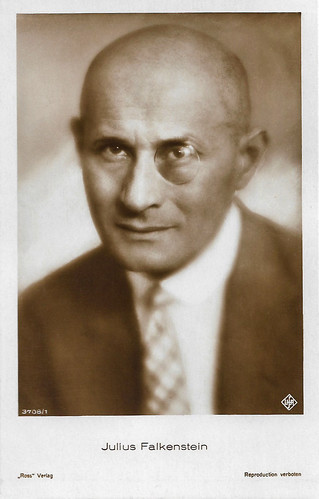
German postcard by Ross Verlag, Berlin, no. 3708/1, 1928-1929. Photo: Ufa.
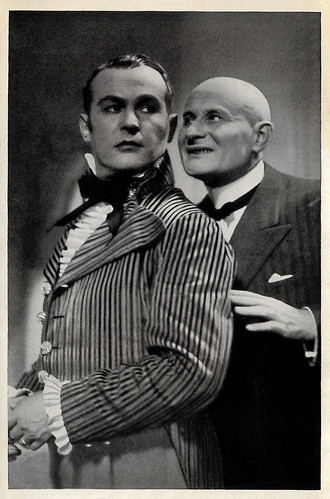
German collectors card in the series 'Vom Werden deutscher Filmkunst - Der Tonfilm', album no. 11, picture no. 32. Photo: Cine-Allianz / Ross Verlag. Jan Kiepura and Julius Falkenstein in Das Lied einer Nacht/The Song of Night (Anatole Litvak, 1932).
Sources: Thomas Städeli (Cyranos - German), Wikipedia (German and English), and .

German postcard by Ross Verlag, Berlin, no. 611/5. Photo: Union / Ufa. Julius Falkenstein and Ossi Oswalda in Die Austernprinzessin/The Oyster Princess (Ernst Lubitsch, 1919).

German postcard by Ross Verlag, no. 636/1. Ohoto: Maxim Film. Lotte Neumann in the comedy Romeo und Julia im Schnee/Romeo and Juliet in the Snow (Ernst Lubitsch, 1920). The man on the left dressed as antique hero could be Julius Falkenstein as Paris. The others are from left to right Jakob Tiedtke (Herr Capulethofer), Marga Köhler (his wife), Lotte Neumann (Julia) and Gustav von Wangenheim (Romeo Montekugerl).

German postcard by Verlag Hans Dursthoff, Berlin, no. 1646. Photo: Ufa Kulturfilm. Julius Falkenstein in Der behexte Neptun (Willi Achsel, 1925).
One of the most popular film comedians of the German silent cinema
Julius Falkenstein was born in 1879 in Berlin, the capital of Germany.
Falkenstein probably received his first theatre engagement in Berlin in 1904/1905. From 1906, he was on stage at the Residenztheater in Berlin. In the following years, he played mostly on the Berlin theaters, interrupted only by engagements from 1908 to 1910 at the Lustspielhaus Düsseldorf, 1911 at the Vienna Volkstheater, and 1912 at the Theater an der Wien. Falkenstein, who was valued above all for his comedic qualities, often went on guest tours and acted himself several times as a game director.
From 1914, he was also prolific in silent films, essaying diverse eccentric character parts. He had his first film appearance in the detective film Die geheimnisvolle Villa/The Black Triangle (Joe May, 1914) the first in the series starring the fictional gentleman detective Stuart Webbs ( Ernst Reicher ), modeled on Sherlock Holmes.
During the silent era, he did his best work for the famous directors Friedrich Wilhelm Murnau and Ernst Lubitsch . For Murnau, he played in Schloß Vogelöd/The Haunted Castle (Friedrich Wilhelm Murnau, 1921), and Die Finanzen des Großherzogs/The Grand Duke's Finances (Friedrich Wilhelm Murnau, 1924) with Harry Liedtke and Mady Christians .
He appeared in such Lubitsch comedies as Der Rodelkavalier/The Toboggan Cavalier (Ernst Lubitsch, 1918) Die Austernprinzessin/The Oyster Princess (Ernst Lubitsch, 1919) starring Ossi Oswalda , and Romeo und Julia im Schnee/Romeo and Juliet in the Snow (Ernst Lubitsch, 1920) starring Lotte Neumann . Julius Falkenstein belonged to the most popular film comedians of the German silent cinema.

German postcard by Ross Verlag, Berlin. Photo: Phoebus Film Julius Falkenstein in the historical comedy Der Meister von Nürnberg (Ludwig Berger, 1927), based on Richard Wagner's opera 'Die Meistersinger von Nürnberg'.

German postcard by Ross Verlag, Berlin. Photo: Phoebus Film. Veit Harlan and Julius Falkenstein in Der Meister von Nürnberg/The Master of Nuremberg (Ludwig Berger, 1927).
The audience has to laugh and cry at the same time
Julius Falkenstein played aristocrats, military, directors, secretaries, and accountants in a stream of films. In addition, he still found time for theater assignments, at the Komische Oper and in the Theater am Kurfürstendamm. He also wrote a comedy himself called 'Julie', which was staged with great success.
IMDb quotes Falkenstein: "It is my wish to play good tragic-comical roles under good directors - roles where the audience has to laugh and to cry at the same time".
The transition to the sound film didn't cause him any trouble. In the 1930s he even made more films than he did in the 1920s. In the last four years of his life, he played in almost twenty films a year.
Among his sound films are hits like Der Kongress tanzt/The Congress Dances (Erik Charell, 1931) with Lilian Harvey and Willy Fritsch , Berlin-Alexanderplatz/Berlin-Alexanderplatz: The Story of Franz Biberkopf (Phil Jutzi, 1931), Ich und die Kaiserin/The Only Girl (Friedrich Hollaender, 1933) starring Lilian Harvey and Das häßliche Mädchen/The Ugly Girl (Henry Koster (as Hermann Kosterlitz), 1933) featuring Dolly Haas .
Falkenstein was Jewish but he secured a special permit to continue making films following the Nazi rise to power in 1933. However, he made only one further film. Julius Falkenstein died of meningitis in 1933 in Berlin, Germany. He was 54. His grave is in the Jewish cemetery in Berlin-Weißensee. He was married to Helene Julie Zillinger.

German postcard by Ross Verlag, Berlin, no. 3708/1, 1928-1929. Photo: Ufa.

German collectors card in the series 'Vom Werden deutscher Filmkunst - Der Tonfilm', album no. 11, picture no. 32. Photo: Cine-Allianz / Ross Verlag. Jan Kiepura and Julius Falkenstein in Das Lied einer Nacht/The Song of Night (Anatole Litvak, 1932).
Sources: Thomas Städeli (Cyranos - German), Wikipedia (German and English), and .
Published on August 18, 2021 22:00
Paul van Yperen's Blog
- Paul van Yperen's profile
- 13 followers
Paul van Yperen isn't a Goodreads Author
(yet),
but they
do have a blog,
so here are some recent posts imported from
their feed.



